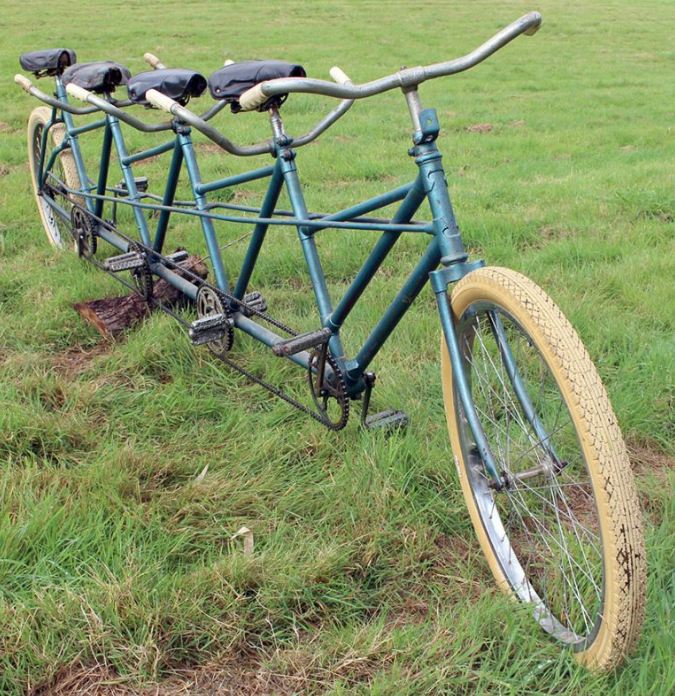This page grew out of the same idea as the N-wheel car page. Four-wheel cars are common, and one-person bicycles are common. But when you start changing the numbers, you can find yourself looking at some interesting technology...
There is already a page on unusual bicycles of miscellaneous types; this page focuses resolutely on the number of riders.

TWO PERSONS
A two-person bicycle is called a tandem, and they are not that unusual. There's one somewhere around where I live; about once a month I see a couple go by on it. There's also a one-person recumbent I see now and then.
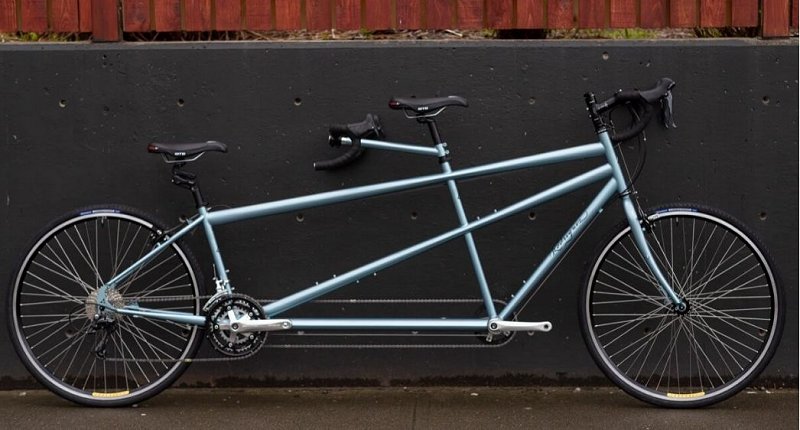 |
| Left: Two-person bike or tandem: 2014
Not particularly unusual, but I thought at least one picture of a standard tandem was mandatory. This is a Rodriguez Custom Classic Touring Tandem, by R+E Cycles of Seattle, USA. The starting price is $4,699; tandems are not cheap. See more here.
This machine has derailleur gears. These can sometimes be problematic on tandem and longer bikes because of the greater cable runs make precise gear-changing harder, and it is also not possible to look down and see what gear you're in.
|
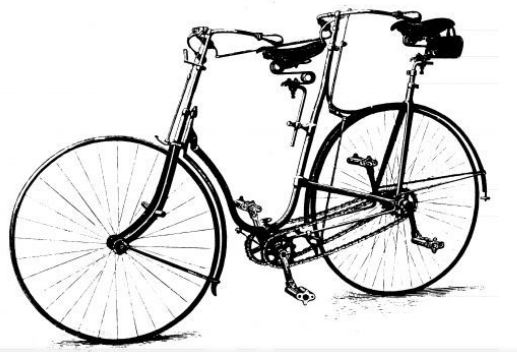 |
| Left: Unusual tandem bicycle: 188?
This demonstrates there is more than one way to build a tandem. Presumably the lack of crossbar at the front is to accomodate a lady's skirts.
The construction looks very light, and I wonder about the structural strength. The machine has not so far been identified.
It looks as though the rear pedals are on a shaft running co-axially through the rear axle, and connect to the front pedals by a 1:1 chain running forward, and there is a conventional chain running back from there to the rear wheel sprocket.
|
 |
| Left: The Rex tandem bicycle: 1898
This looks like a conventional tandem, except that it has a small extra wheel at the back. There is no explanation of the third wheel anywhere in this advert.
The one-person bicycles at the bottom of the ad also have third wheels.
|
 |
| Left: The Rex single-person bicycle: 1898
This modern picture reveals that the curved tube is pivoted on the main frame, and the bracket holding the third wheel is pivoted just by the rear axle of the second wheel.
I conclude that this arrangement, including the weight of the rider and the flexibility of the curved tube, constituted a suspension system for the third wheel. The intention was presumably a smoother ride; the advert dwells on easy riding but strangely does not mention the third wheel.
It looks as if only the rear rider got the benefit of the suspension; hardly fair on the wife.
|
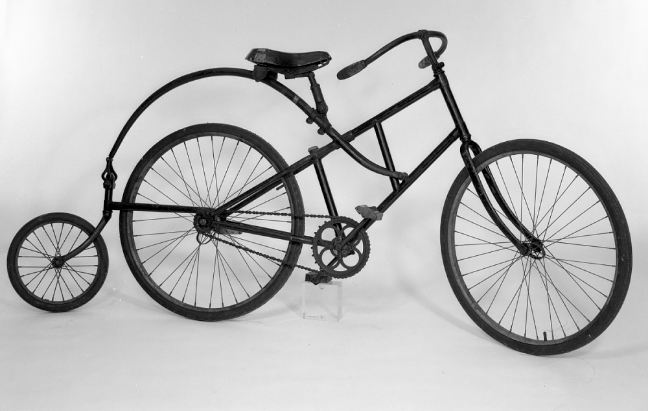 |
| Left: The Rex single-person bicycle: 1898
There are supposed to be only two Rex tandems in existence. One is in the Henry Ford Museum.
The other is owned by Mr Harry Kraemer and you can see him riding it from the rear seat on YouTube for about six seconds. No obvious suspension action is visible. Note that Kraemer's Rex has its front and rear handlebars linked together for steering.
|
 |
| Left: The Warwick Tandem: 1897
There are two interesting things about this tandem. Firstly both handlebars steer; you can see the bar linking front and middle down-tubes.
Secondly, the frame has the 'hygienic attachment'. If that sounds baffling, and possibly rather sinister, note the cylinder just below the rear saddle which contains a suspension spring. It was asserted that less jarring of the internal organs improved your health.
Note also the unusual skeleton chain-guard.
|
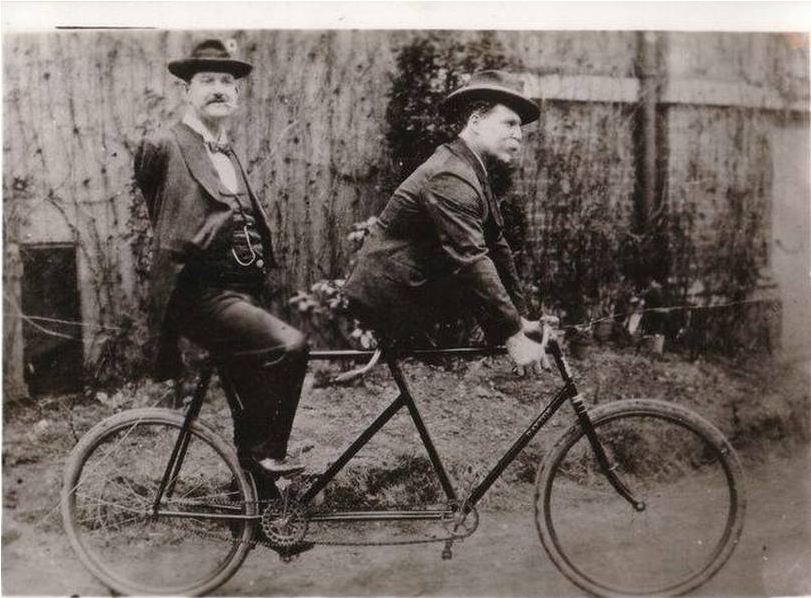 |
| Left: Tandem unusually manned: 18??
Pictures of tandems are common, but this one is something special. Here an armless man (C. Tripp) and a legless man (E. Bowen) are posed on a tandem.
Charles B. Tripp (6 July 1855 – 26 Jan 1930) was born in the city of Woodstock, Ontario, Canada. He was born without his arms, but learned to use legs and feet to carry out daily tasks, becoming a skilled carpenter and calligrapher.
Eli Bowen (14 Oct 1844 - 4 May 1924) from Ohio, USA, was an acrobat without legs, known as "The Legless Wonder".
One wishes them the best, but it is hard to see this as a practical transport proposition.
|
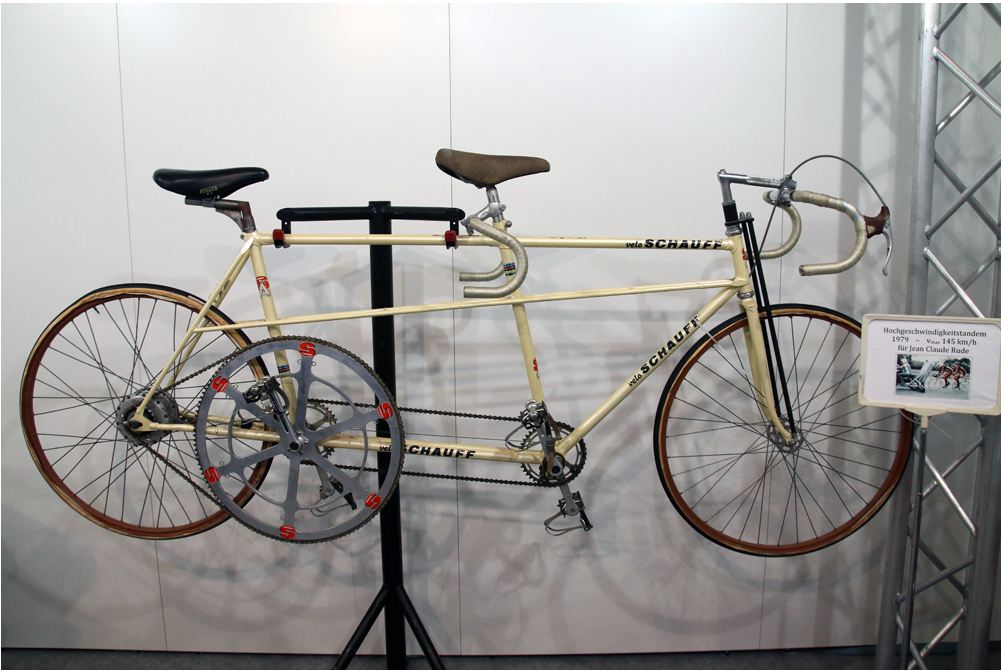 |
| Left: Record-breaking tandem: 1979
In 1979 Hans Schauff built a high speed tandem for french racer Jean-Claude Rude. A top speed of 145 km/h (about 90mph) was reached on a autoroute in the Alsace by M. Rude and his blind stoker (rear rider) running behind a windbreak attached to the rear of a motorcycle, setting the World speed record for tandems at that time. The tubular tires were taped to the wheel rims.
Note the enormous chainwheel to give an adequate step-up ration
There is more info on the Schauff website.
|
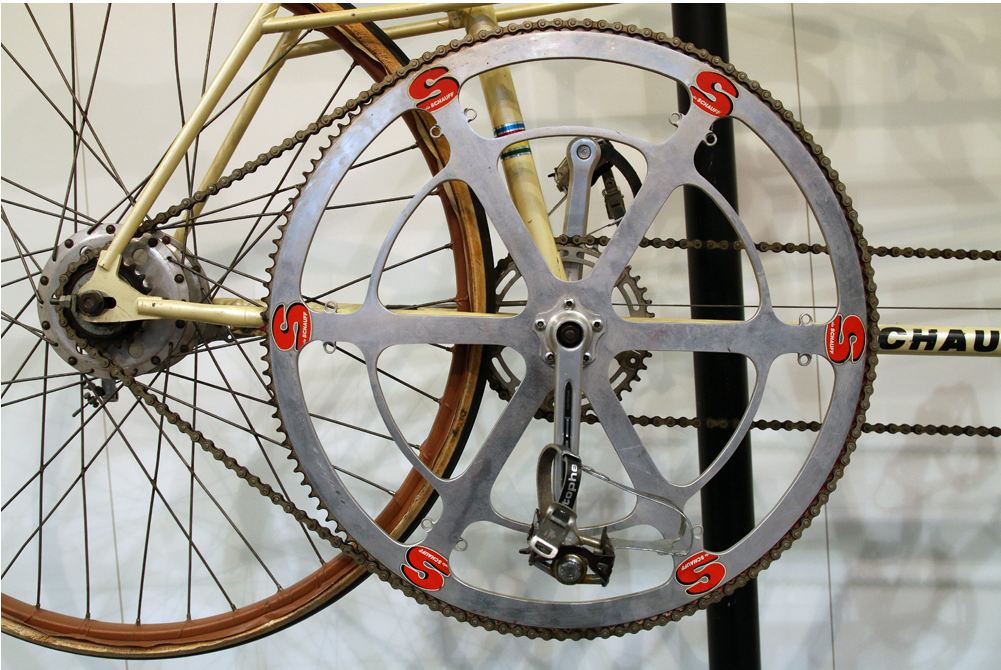 |
| Left: Record-breaking tandem: 1979
Now that is a chainwheel. There is only one gear.
Tandem speed records seem to be unaccountably hard to find; at present it appears M. Rude's record still stood in 2019.
|
 |
| Left: Tandem load-carrier: 15 December 1940
This is a Dutch load-carrying tandem used by telephone installers of the PTT; note the symbol on the front.
It was steered by swivelling the big box on the pivot shown underneath.
It looks like it would hard pedalling even with two men on the job, but then Holland is notably flat. I don't see this vehicle being much use in hilly country.
If you're wondering why the man in front is looking grim, it's probably because his country was invaded by Germany in May 1940.
|
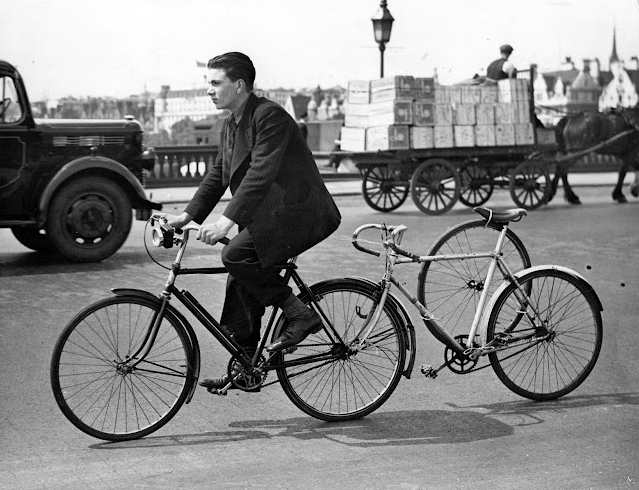 |
| Left: Improvised tandem bicycle: 1939
This was photographed in London in 1939. The man has built a tandem simply by bolting together two ordinary bikes. If there is no rear rider, you can carry a spare wheel. Since only the front wheels steer, there might be some issues with cornering.
I thought the man's name was George W Hales, but that turns out to be the name of a photographic agency.
Horse-drawn transport still very much in evidence here.
|
 |
| Left: Malvern Star abreast tandem bicycle: 1930s
A tandem is not the most sociable of affairs, with one rider staring into the other's shoulder-blades. The Malvern Star had the solution; put the riders side-by-side. Malvern's main output was conventional bikes, and they are still in business today.
Both handlebars are connected to the steering, so there'd better be good agreement about which direction to go in. Even so, keeping a bicycle upright is accomplished by making continuous small steering changes, so looks as if it might be best to have one rider designated 'Captain'.
Further research indicates that the Malvern abreast bicycle was actually a replica of a machine built in 1897 called the 'Punnett Sociable'; the replica was constructed for Malvern's 50th anniversary celebrations.
There is a short Wikipedia page on sociable (side-by-side) bicycles. An inherent problem is that wind resistance is much increased over a conventional tandem.
|
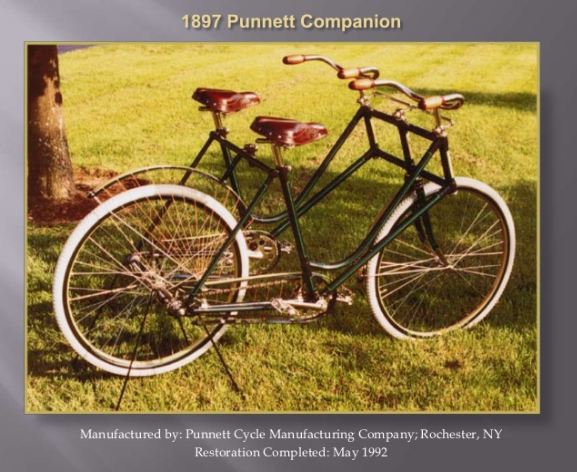 |
| Left: Original Punnett Sociable abreast tandem bicycle: 1897
This is an original Punnett Sociable restored. The idea was patented by Albert Weaver of Hamilton, Ontario, and manufactured by the Punnett Cycle Manufacturing Company of New York.
You can see that between the two saddles there is another mounting for a central saddle. If there was only one of you, then you moved one of the saddles to the central position, and off you went. Or did you? You would have to use the 'wrong' pedals on each side, but more of a challenge would be steering, which was supposed to be done by grasping the two inner handgrips, which would reverse the steering. In fact the machine could be ridden with just one person on one side, as confirmed by the replica below.
There are many pictures of abreast sociable bicycles and tricycles at onlinebicyclemuseum.co.uk.
|
 |
| Left: The Punnett abreast tandem bicycle:
This photograph appears to be from the 1940s or 1950s, and so that is probably an original Punnet bicycle.
An amicable agreement about the steering seems to have been reached.
|
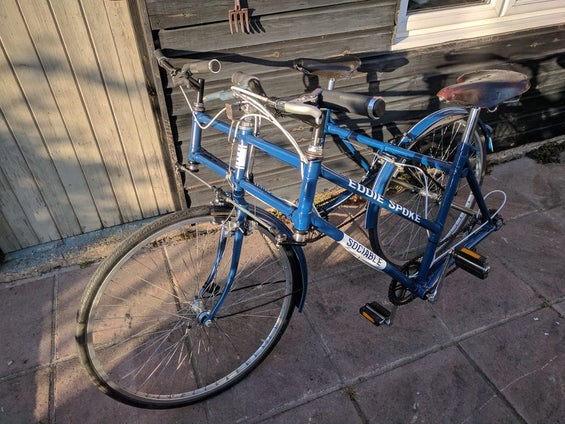 |
| Left: Replica of the Punnett abreast tandem bicycle:
This is a modern replica of the Punnett Sociable. There are full details of the construction process here. At the end of the page is a video demonstrating that it is possible for one person to ride the machine, which has no mounting point for a central saddle, with a bit of judicious leaning to the appropriate side.
|
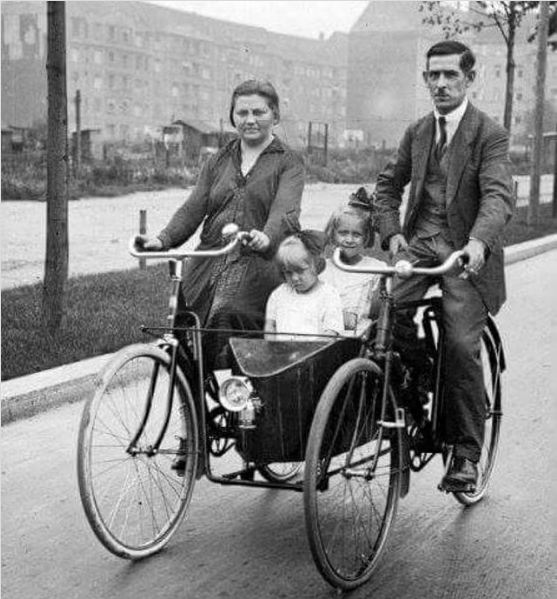 |
| Left: Abreast tandem bicycle with mid-car: 1927
This photograph appears to be of a Dutch family in 1927. Note that the handlebars are linked for steering.
|
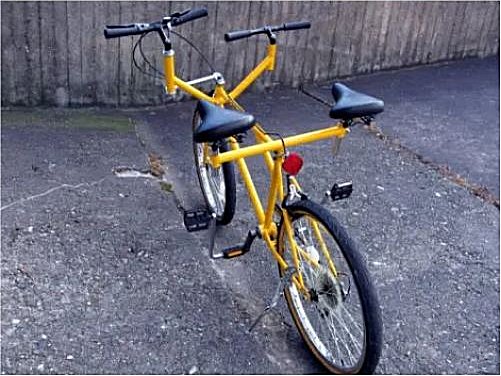 |
| Left: Modern abreast tandem bicycle: 20??
Here is another approach to the 'sociable' tandem. Here only one of the handlebars is connected to the steering, and it also carries the brake levers and gear shift. No doubt about who's in command here.
Note the elegant way in which two sets of pedals are provided on a single frame.
Source unknown
|
 |
| Left: Wolff & Co Duplex tricycle: 1896
Both handle bars are connected to the front fork for steering. There is no sign of any brakes.
Note dual chain drive to rear wheels, so no differential is required.
There is more info here, and also here.
|
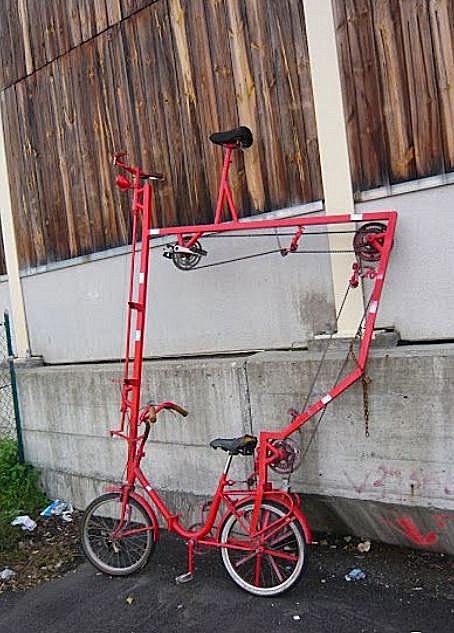 |
| Left: Stunt tandem bicycle: 20??
Some people just have to do things the hard way. Here the two riders are not one behind the other, but one on top of the other. Both handlebars appear to be connected to the steering.
Oviously this counts as a freak bike and is in no way practical transportation. You might have to look out for low bridges.
Source unknown
|
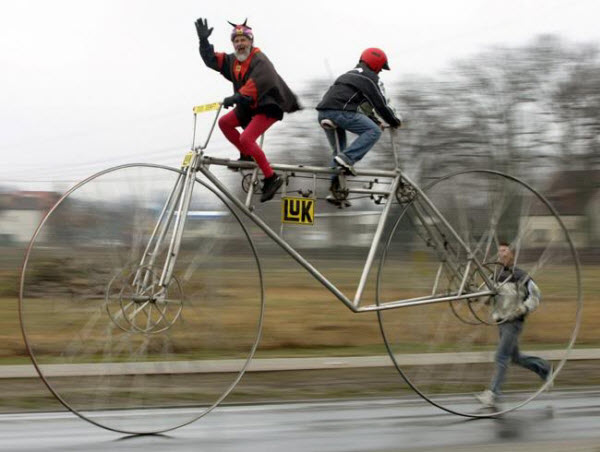 |
| Left: Giant tandem bicycle: 2005
You would need to keep an even warier eye out for low bridges with this machine.
- Length: 7.8 m
- Height: 3.7 m
- Wheel diameter: 3.32 m
- Weight: 150 kg
- Construction 150 m of aluminium pipe
It is unusual for the rear tandem rider (often called The Stoker, the front rider is sometimes called The Captain) to face backwards.
It is claimed to be the largest (for some definition of largest) bicycle in the world. It was built by German artist Didi Senft in 2005. More info here, and also Didi Senft has a website.
|
 |
| Left: Giant tandem bicycle: 2005
Note the name 'Didi Senft' on the front. It all looks a bit of a risky business, cycling at that height on a wet road. Presumably out of shot there is a big step-ladder.
|
 |
| Left: Stunt tandem unicycle: 20??
So you have two riders, but who says you have to have two wheels? This unicycle presents the ultimate challenge in keeping two riders co-ordinated.
Yes, I do realise that it is a unicycle and not strictly a bicycle.
Source unknown
|
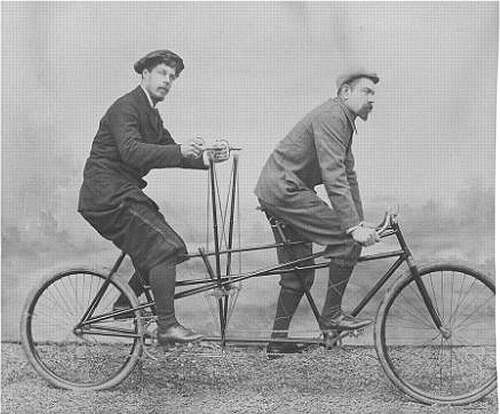 |
| Left: Hand-propelled tandem: date unknown
A praiseworthy effort at getting more power out of your stoker (rear rider) by having him haul on a pair of levers. The image quality is not good but there appears to be two connecting rods that route the power to the chainwheel under the rear rider. Note that the hand-levers are made of thin rods or tubes braced with wire, to minimise weight.
I suspect the rear rider may have some trouble in keeping his balance without a fixed pair of handlebars to cling to.
Nothing is known about this picture. An image search yielded nothing.
You can see a modern tandem with hand propulsion by the rear rider (using a hand-crank and chain) on YouTube. The lady on the back does have fixed handlebars as well as the hand-crank. Doesn't look all that practical to me.
|

TWO AND A HALF PERSONS
Half a person here referring to a child. Two adults plus one child was the most common configuration.
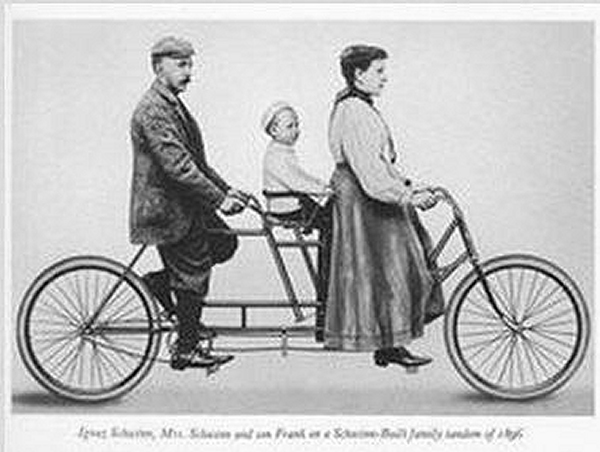 |
| Left: Family tandem bicycle: 1896
So you have two riders, plus an extra seat for a child, which seems to have involved a lot of extra tubing. Just how heavy was young Frank?
The caption says "Ignatz Schwinn, Mrs Schwinn and son Frank on a Schwinn-built family tandem of 1896". Ignatz Schwinn was the head of the Schwinn biycle company.
There is more info here.
|
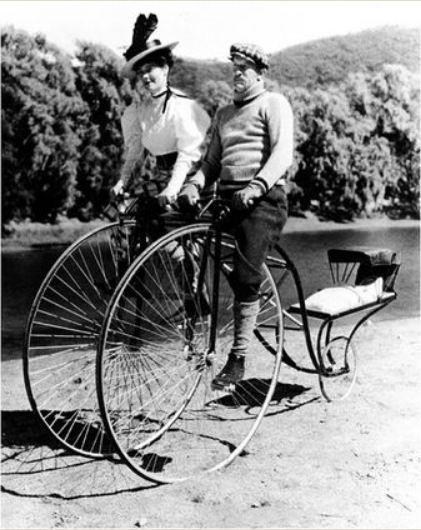 |
| Left: Family double penny-farthing: 1910?
Again two riders, plus towed baby. Looks like the baby might be subjected to a rather rough ride bouncing along at the back there, though it does appear to be on springy supports.
At least the weight of the baby made it less likely that you would pitch forward.
Source unknown. An image search has revealed nothing.
|
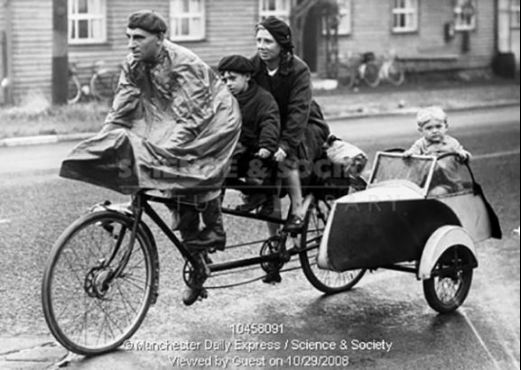 |
| Left: Tandem with sidecar: 1930s
Tandems with attached sidecars were fairly common in 1930s England and Europe; many pictures can be found on the Net. Put 'tandem sidecar' into Google and you will find dozens of them.
The young lad in the middle appears to seated uncomfortably on the rear handle bars; perhaps there was some sort of saddle.
Location: England, 1930s
|
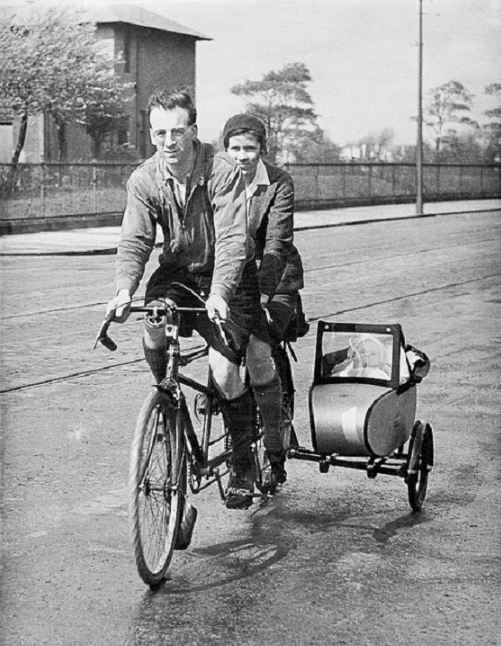 |
| Left: Tandem with sidecar: 19??
This looks like it was taken at a later date. Probably best not tried in heavy traffic.
Source: unknown. An image search has revealed nothing.
|
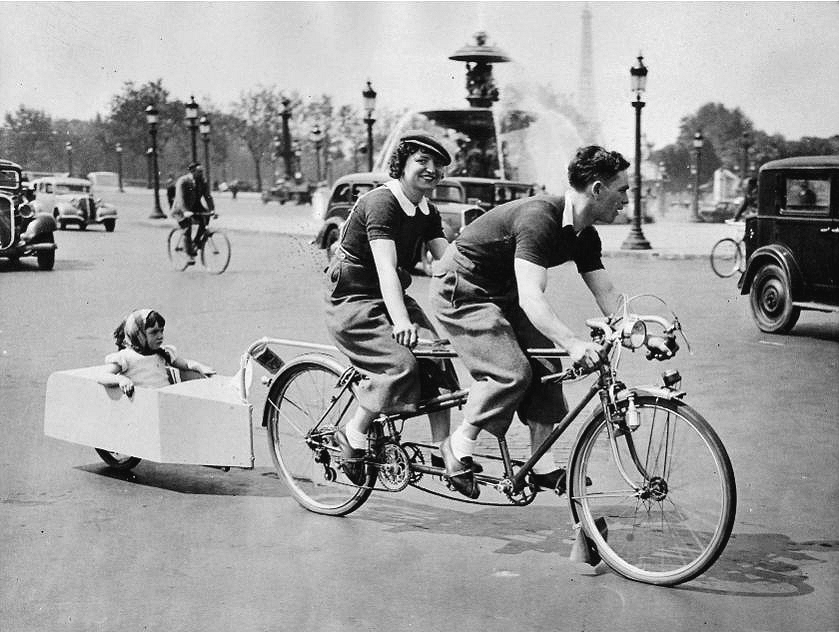 |
| Left: Tandem with sidecar in Paris: 19??
Here we have a one-wheel trailer towed by a tandem. Dogged detective work has allowed the Museum Staff to locate this fairly precisely, being somewhat helped by the Eiffel Tower being visible in the distance. I think the location is probably the Place de Concorde.
Judging by the car styling the date is probably the late 1940s, but this is far from certain.
Source: unknown. An image search has revealed nothing.
|

THREE PERSONS
A 3-person bike is usually called a triple, though The Goodies of course called theirs a 'trandem'. Tridem and Triplet have also been used as names. Predictably, they are much rarer than tandems and a good deal more expensive.
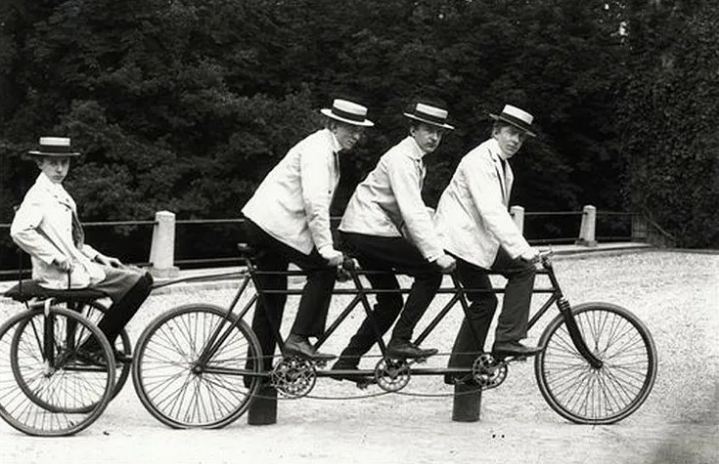 |
| Left: Triple with two-wheel trailer: 192?
This triple is towing a two-wheel trailer for a fourth (rather smaller) person.
An image search has revealed nothing.
|
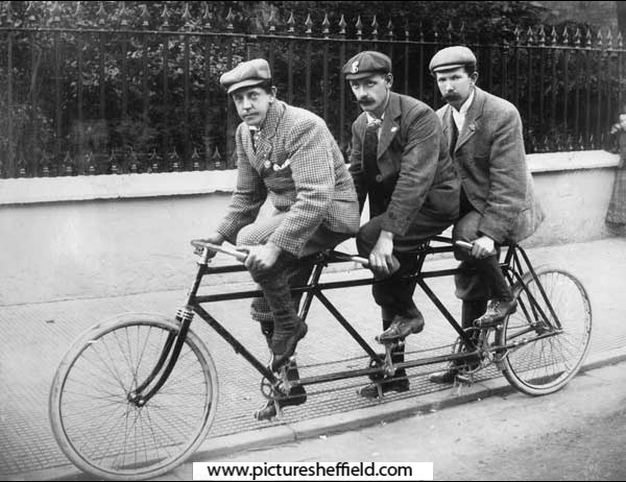 |
| Left: Triple : 19??
This photograph comes from the archives of the Sharrow Cycle club near Sheffield. The club still exists.
Intriguingly, this machine looks like it might be the same as the one pictured just above towing a trailer. Note the double tubes extending from the rear seat to the rear axle, and the triple rings on the front fork.
Note the cap and lapel badges, a common feature of cycle clubs of the day.
|
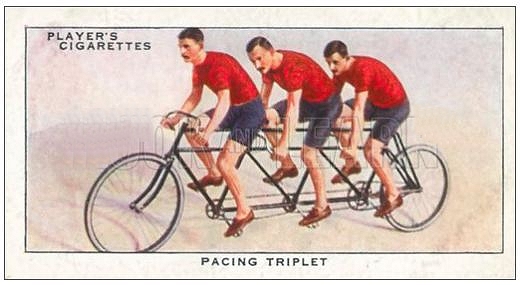 |
| Left: Cigarette card showing pacing triple: date unknown
Not much to add here, except that rather surprisingly none of the riders are wearing socks.
|
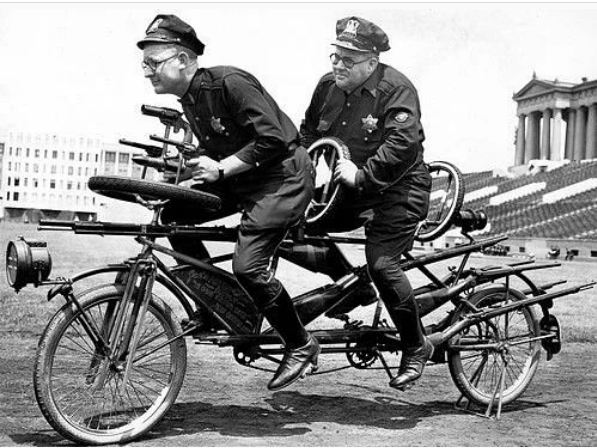 |
| Left: Police 15-gun triple: 1941
This remarkable triple, here with only two men mounted, carried an arsenal of 15 guns. This is a rehearsal for the Police and Fire Thrill Show in Chicago on 13th July 1941. at Soldier’s Field. The front man is Frank Folsom, and the man on the right is Robert Williams.
I can only count 5 rifles facing backwards, one rifle facing forward attached to the upper frame tube, and two revolvers plus a flare-gun fitted to the handlebars. The front man is ready to fire one of the revolvers. Presumably this was a way of delivering guns to an incident, and the rifles were not meant to used in situ.
One of the many questions about this photograph is the presence of three extra wheels instead of, or in addition to, conventional handle bars.
|
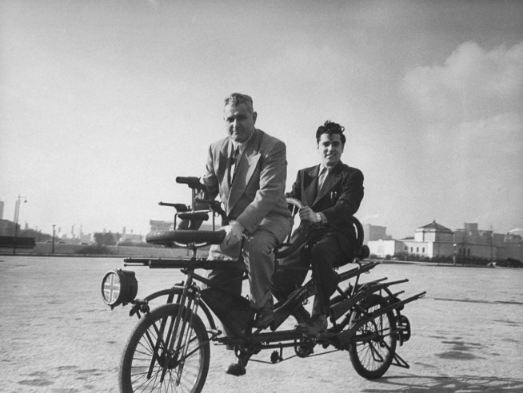 |
| Left: Police 15-gun triple: 1941
The same triple, again with only two men mounted; was it impractical to carry a third man, for some reason? With all that weight of weaponry, I would have thought that the extra horsepower would be necessary. According to the original caption, "Gangbusters Bike mounts 13 shotguns, two revolvers, six bayonets, and a flare gun." Bayonets??
As before there are three extra wheels (possibly from children's bicycles) instead of, or in addition to, conventional handle bars. This is very odd.
Note what looks like an idler sprocket tensioning the chain between the first and second chainwheels.
|
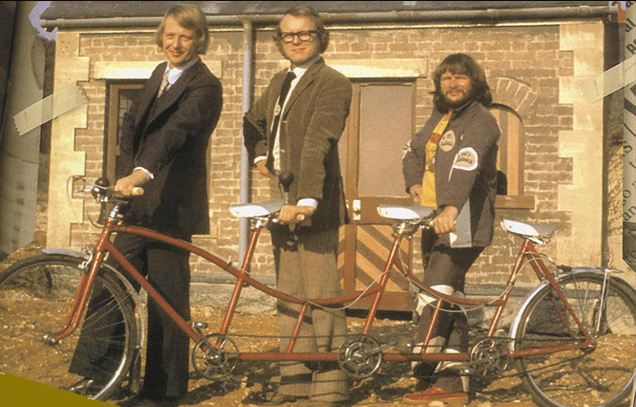 |
| Left: Three-person bike; the Goodies trandem: 1970s-80s
This must be one of the more famous triples. There were in fact three different triples used in the various series of the Goodies, as recorded by The Guardian.
Note the lower saddle for Bill Oddie.
|
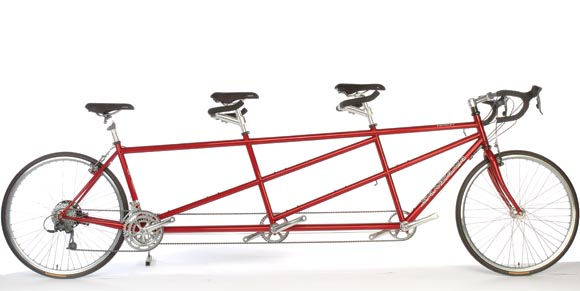 |
| Left: A conventional triple: 20??
Triples require rather more rider co-ordination than tandems do. There is some helpful advice here.
|
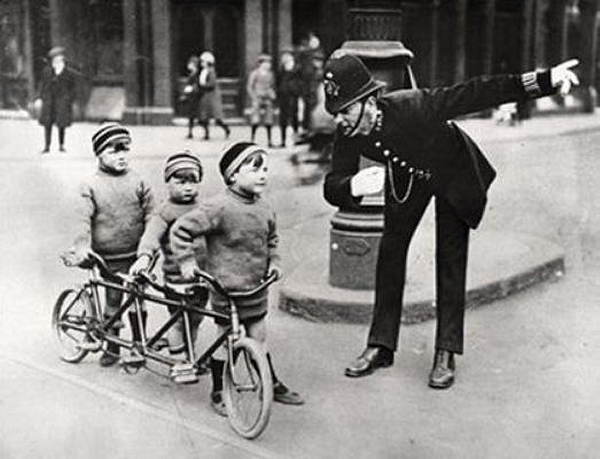 |
| Left: A triple: 192?
Someone has obviously gone to the expense of building a child-size Triple, presumably as some sort of publicity stunt.
"First left for the workhouse, sonny."
Source unknown. An image search has revealed nothing. A study of the policeman's uniform would help narrow down the date.
|
 |
| Left: Jim Gallant's Kid-First Trandem: 20??
Jim Gallent built this bike to arrange his children in order of size so everyone could see where they were going. The steering is firmly under the control of the third rider. You can see his home-built Human-Powered Vehicles (HPV) here.
Note hefty 2-inch tube along the bottom of the frame.
|
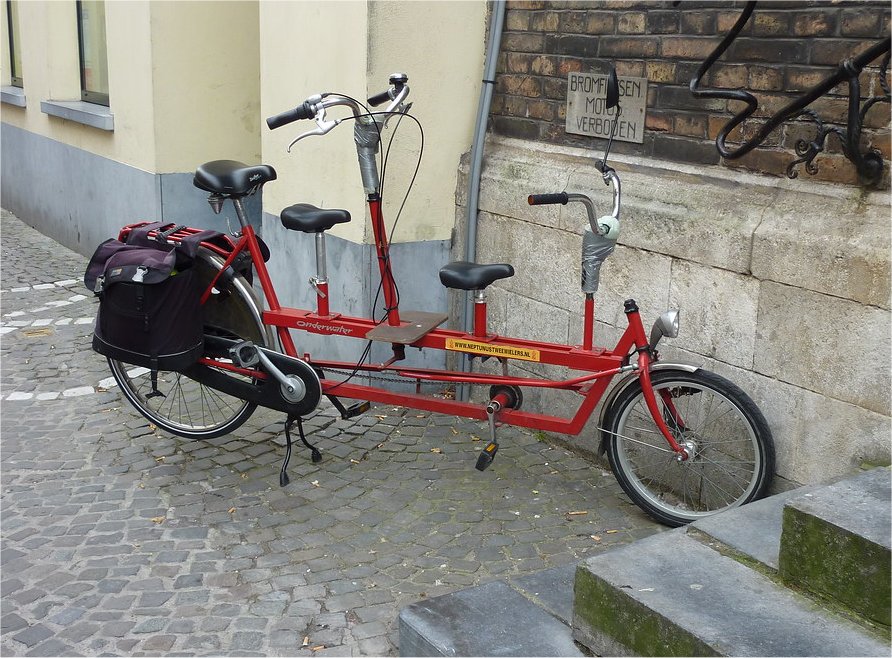 |
| Left: Spotted in Bruges in March 2010
The bike has been identified as a Onderwater family-triple. A third child seat can be added to the rear carrier.
The name Onderwater can be seen on the rear of the frame. Unsurprisingly, it means 'underwater' in Dutch. Given the number of canals in Amsterdam and other Dutch cities, usually unfenced, that sounds rather ominous.
However, further research by the Museum Staff revealed that the bike was designed by Ronald Onderwater.
|
 |
| Left: Workcycle family triple in use
The name on the side of the bike is 'WorkCycles' as seen here, not Onderwater, though the design appears to be identical.
The smallest child is excused pedalling.
There is a web page for Workcycle, but it does not currently show this model.
|
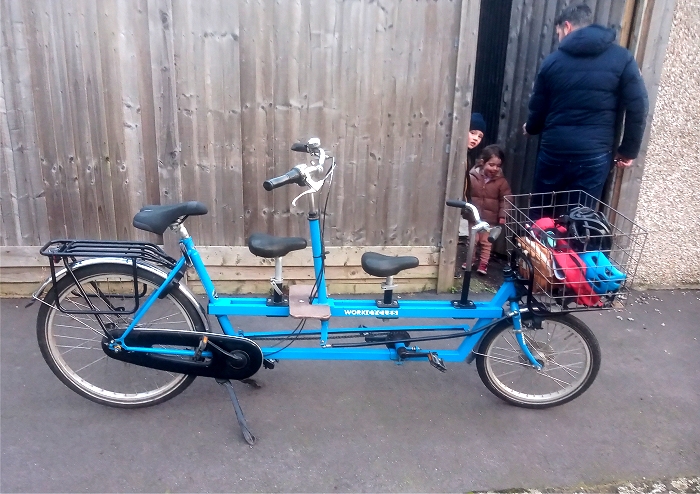 |
| Left: Workcycle family triple: now
A man who lives down the road from me has a Workcycle, and here it is. He uses it to transport his two children.
Photographed by permission.
|

FOUR PERSONS
A 4-person bike is usually called a quad or quadruplet.
 |
| Left: The Cambridge quad: 1895
Quads were widely used as pacing machines for racing bicycles. Judging from the caption, this is the pacing quad of the Cambridge University cycle-racing club. Cambridge University quad- there's a joke in there somewhere.
The pacing issue was so important to bicycle racing because it reduced wind resistance. Wind resistance increases by the square of the velocity, so the effect is dramatic: a ten percent speed increase requires a twenty percent increase in power. Pacing used another vehicle running just in front to shield the competitor from the air. In the last quarter of the nineteenth century, when cycling was dominated by records, paced record attempts became an integral part of cycle sport. This sort of thing is not encouraged nowadays, which I think is a great pity. A quad rushing past at 40mph must have been an impressive sight.
The first pacers were cyclists mounted on the same type of bicycle as the competitor. They would be replaced at regular intervals, allowing the “stayer,” the
cyclist making the record attempt, to travel at the top speed of his pacers. Even greater speed was realised by substituting solo pacers with multi-cycles – tandems, triplets,
quads and even quints- that were specially designed for the purpose of track pacing.
You can see a steam-powered pacing tandem on the steambike page, with an illustration of the odd riding positions required.
|
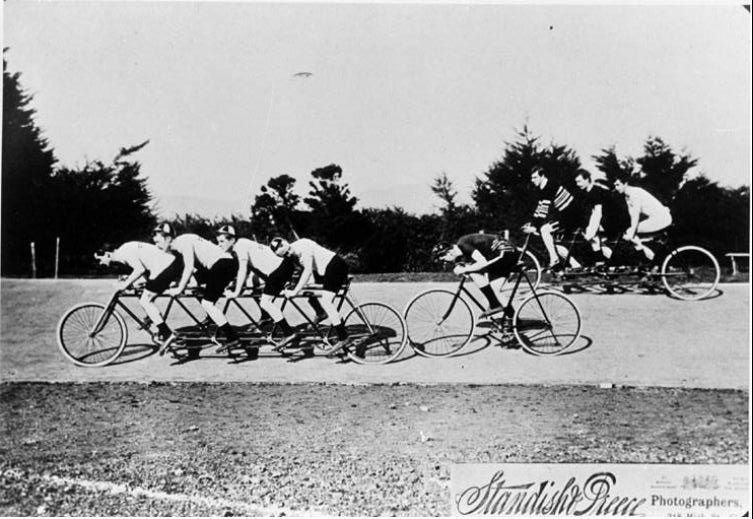 |
| Left: Pacing at Lancaster Park: ca 1890
A quad and a triple pacing a cyclist at Lancaster Park in Christchurch, New Zealand. The stadium was demolished after damage sustained in the February 2011 earthquake.
This looks very like a circuit with banked track, which may give some clue as to why so many of these machines were built without brakes. You just stopped pedalling and coasted to a stop, with no danger of running out of road.
Source: Christchurch City Library, file reference: CCL PhotoCD 1, IMG0073.
|
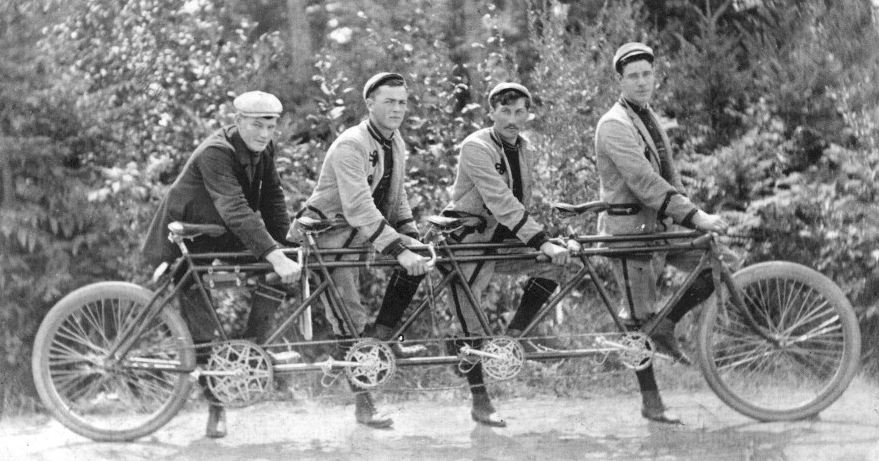 |
| Left: A quad in Australia: 1890?
Note the size of the chainwheels increases toward the rear of the machine.
Source: City of Victoria Archives PR91-7960 M08267
|
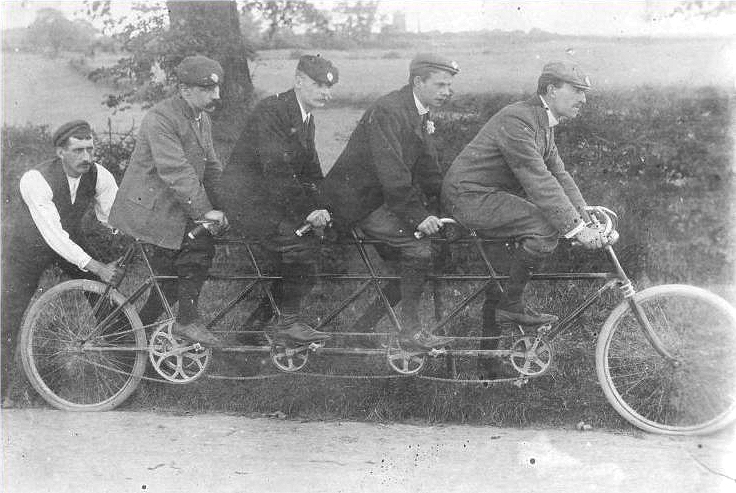 |
| Left: A quad in Kegworth village: 1890?
The location is all that is known about this photograph. The riders have badges on their caps, probably denoting membership of a cycle club.
|
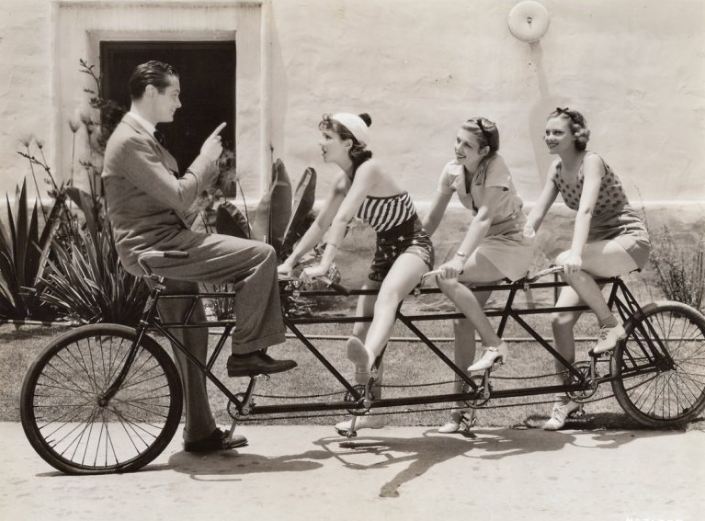 |
| Left: Robert Montgomery and three starlets: 1933
Here is actor Robert Montgomery mansplaining the art of quartet riding. This photo was taken in 1933, used as a publicity shot for the film Night Flight, which does not seem to feature a 4-person bike.
The three young ladies are Jean Parker, Irene Hervey and Jean Howard.
|
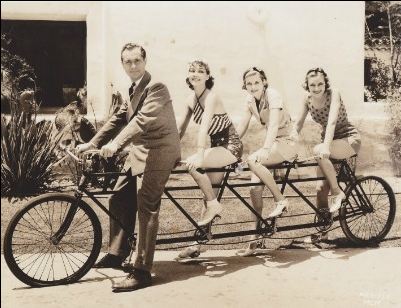 |
| Left: Robert Montgomery and three starlets: 1933
|

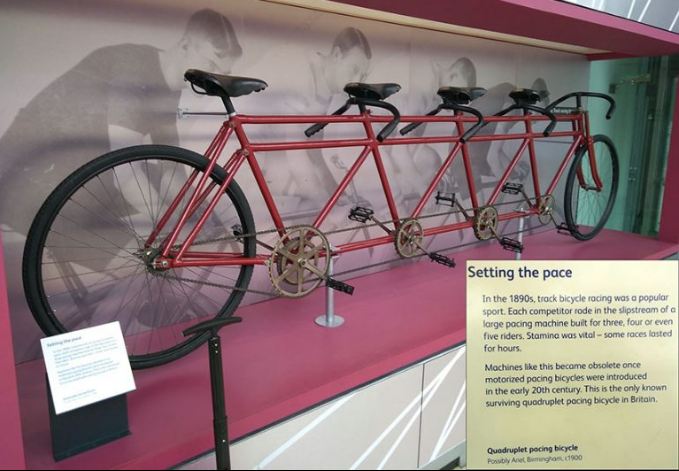 |
| Left: Pacing Quad: c1900
Quadruplet pacing bicycle. It is said to have possibly been made by Ariel, of Birmingham, but it looks nothing like the advert for the Ariel Quintette.
The inset placard claims this is "the only known surviving quadruplet pacing bicycle surviving in Britain". I don't know if that is true or not.
This machine is part of the permanent collection of the National Museum of Scotland, Edinburgh
|
 |
| Left: Pacing Quad: c1900
The little grey notice at top right says "Track racing b... did not use bra..." which confirms that pacing machines did not have brakes, and there is certainly no sign of them here.
This machine is part of the permanent collection of the National Museum of Scotland, Edinburgh
|
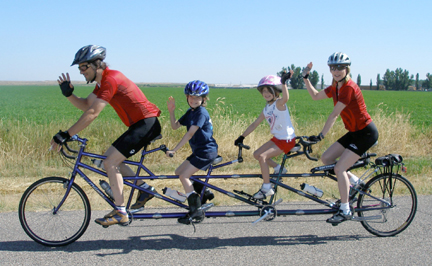 |
| Left: A Quad: 19??
Riding quads and quints is often a family affair.
|
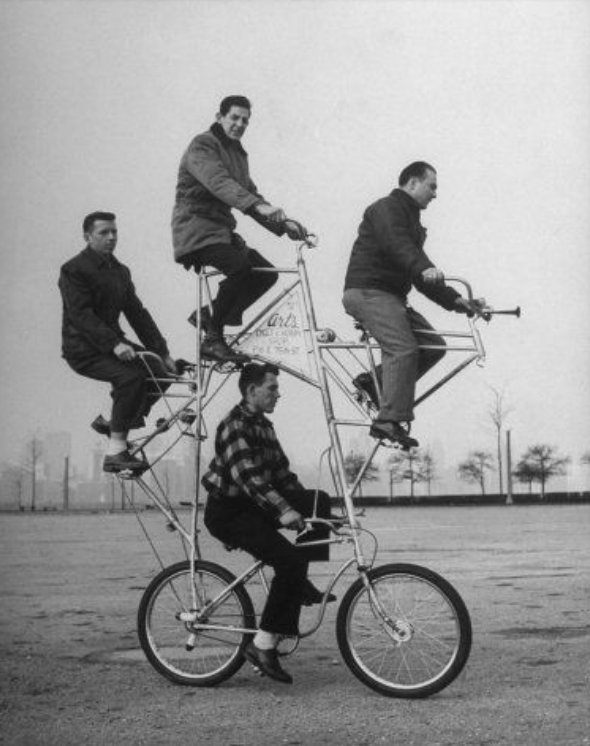 |
| Left: An unusual Quad: 1948
This is clearly a freak bike rather than a practical transport proposition, but it undoubtedly carries four people.
It was reported in the 27 December 1948 issue of Life magazine, in an article titled "Hell on Wheels: Life on Mutant Bicycles" It was describing the projects of a group of Chicago bicycle enthusiasts.
It's not clear if the machine in this picture is moving or not. There is no motion blur, but a fast shutter speed would have eliminated it. There is no sign of external support to hold up the bike if it is stationary, but on the other hand there is no sign of it leaving tracks on what appears to be grass.
The Museum Staff have decided that no more freak machines like this will be added to this Gallery.
|
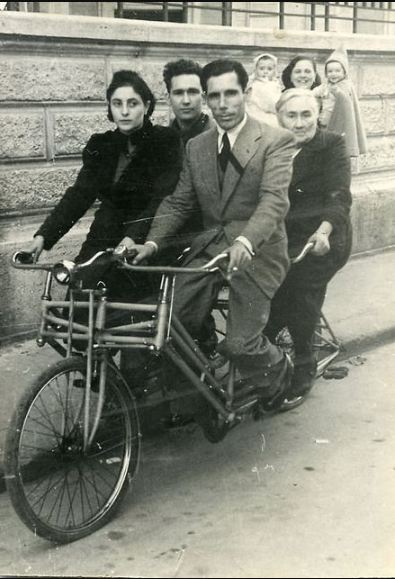 |
| Left: A Quad: 19??
This is an enigmatic picture. There are clearly four people aboard but there is only one front wheel and the rear wheel is barely visible. The two-abreast format is like that of the Malvern Star.
The man at the front has his handlebars connected to the front forks, and he also controls the brakes. The lady next to him can only look wistful.
An image search reveals nothing. Something about the picture suggests Paris to me.
|

FIVE PERSONS
A 5-person bike is usually called a quint. Quints used for pacing or racing could reach an intimidating 60 MPH. With (usually) no brakes.
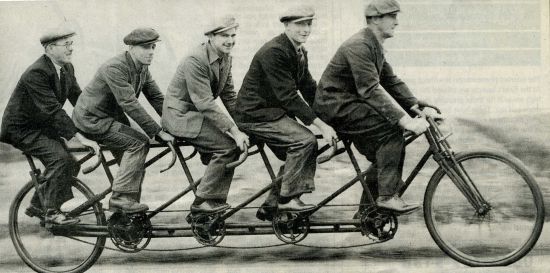 |
| Left: A quint: 1950s?
It is noticeable that this machine has more frame bracing than the Schwinn quint below. The rear rider is seated behind the rear axle, and it is not clear if he has any pedals to use; the drop handlebars indicate a machine made for racing and pacing, and if that's true the fifth many would certainly have pedals. Note the large chainwheel under the fourth man.
I don't see any brakes.
Source unknown. From the clothing it might be Britain in the 1950's.
|
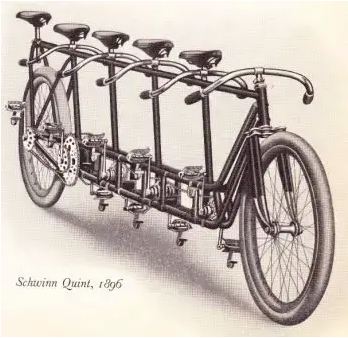 |
| Left: A Schwinn quint: 1896
Schwinn was (and is) a major manufacturer of bicycles. In addition to quints, they bulit triplets and quads. Note the double bottom-tube and the heavyweight tyres.
|
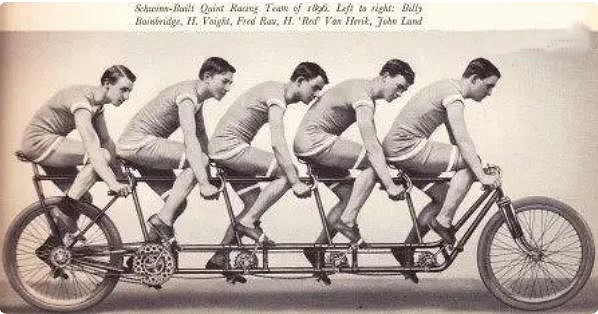 |
| Left: A Schwinn quint: 1896
This is the Schwinn quint racing team in 1896.
Again, the rear rider is seated behind the rear axle, (presumably to make the machine shorter, and so save weight) but this time he certainly does have a set of pedals- there is no room for passengers in racing. The pedal shaft seems to run co-axially through the rear axle, and a chain runs forward to the big chain-wheel under the fourth rider.
|
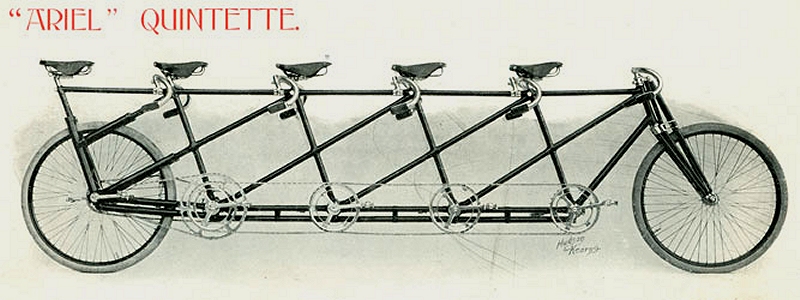 |
| Left: Advert for an Ariel quint: 1899
Here are three equal chainwheels at the front, with a final step-up triple chainwheel under the fourth rider.
This quint is called a 'quintette'; why not a 'quintet'?
|
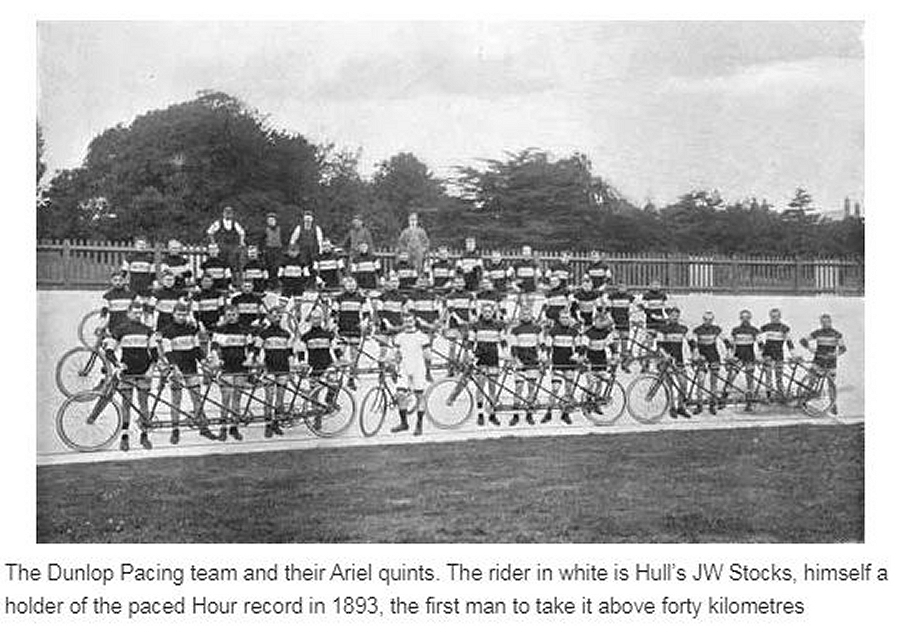 |
| Left: The Dunlop Pacing Team: 1893?
There are eight, possibly nine, Ariel quints in the picture; three of them survive today. John William Stocks was the professional rider for Ariel in the late 1890's.
|
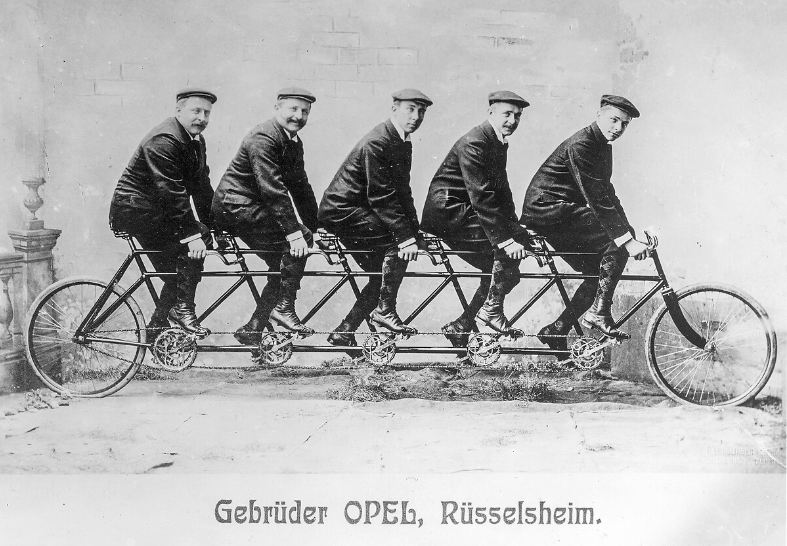 |
| Left: Quint made by Opel: 1895
The caption says "The Opel Brothers". The five sons of founder Adam Opel, (Carl, Wilhelm, Heinrich, Friedrich and Ludwig) were cycling enthusiasts and successful racers, acting as PR professionals for their father’s business by racing his bikes and winning over 560 races in all.
No sign of any brakes.
|
 |
| Left: Unknown Quint: date unknown
I had this down as an unknown quint, with an image search revealing nothing. But... this is obviously the same machine as in the Opel picture just above, in the same photographic studio. So far as I can tell it is the same five brothers, though standing in a different order.
No sign of any brakes.
|
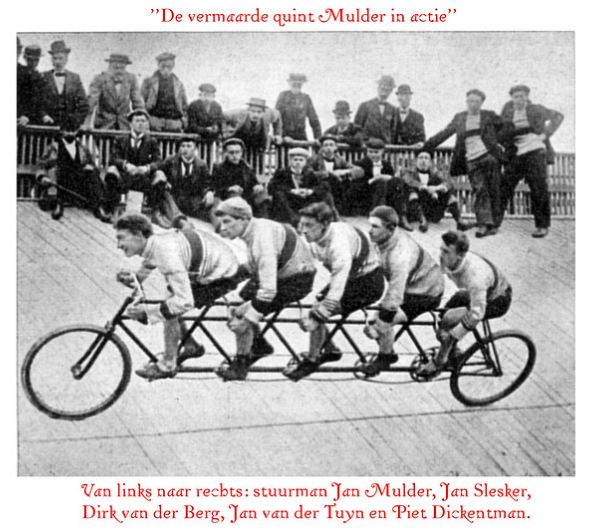 |
| Left: A Dutch quint on a banked track: 1900-ish
The top caption says "The renowned Mulder quint in action", with the names of the riders in the bottom caption, starting with Jan Mulder.
No sign of any brakes.
|
 |
| Left: A Dutch quint on a cycle track: 1900-ish
The Mulder Quint was a very successful team around 1900. (F.i. world champion 1898) The leader Jan Mulder had the nickname 'the wooden' ('de houten'), which was presumably a reference to his stamina.
From left to right: Piet Dickentman, Jan van der Tuyn, Dirk van der Berg, Jan Slesker, and Jan Mulder. Piet Dickentman became European stayers champion in 1900, and world champion in 1903.
No sign of any brakes.
|
 |
| Left: Five USA soldiers on a quint: 19??
Note the truss-style construction of the upper tube, which appears on no other quint in this section.
|
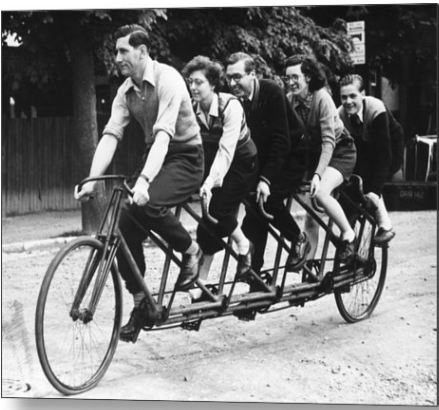 |
| Left: Dunlop quint: 1897/1955
From a newspaper report on 4th June 1955: "Five people riding an 1897 Dunlop Racing quint in a bid to beat Britain's national railway strike."
|
 |
| Left: A quint in Norwich: 19??
Photograph taken at a Norwich Amateur Bicycle club meeting. Date unknown.
|
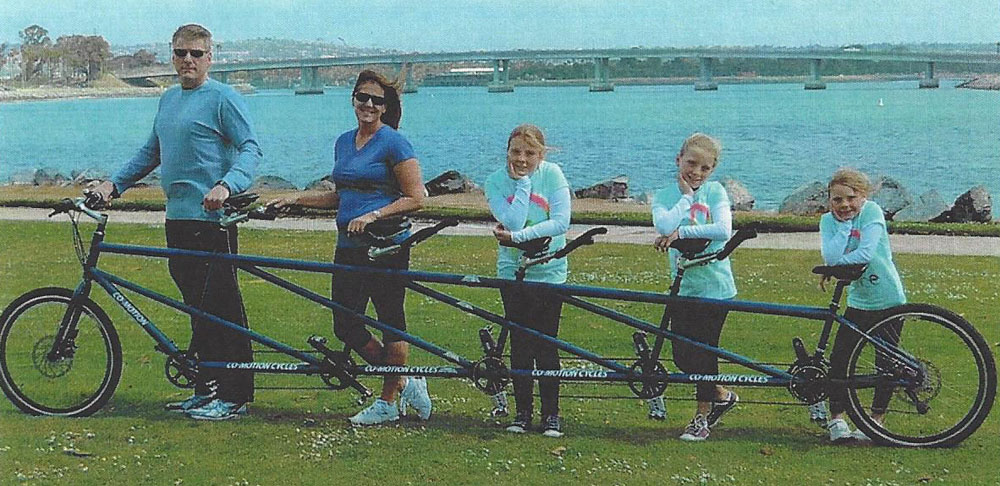 |
| Left: A modern family quint: 20??
Note how the top tube slopes downward to the rear to allow for different heights of saddle.
The lettering on the bottom tube reads 'CO-MOTION CYCLES'
|
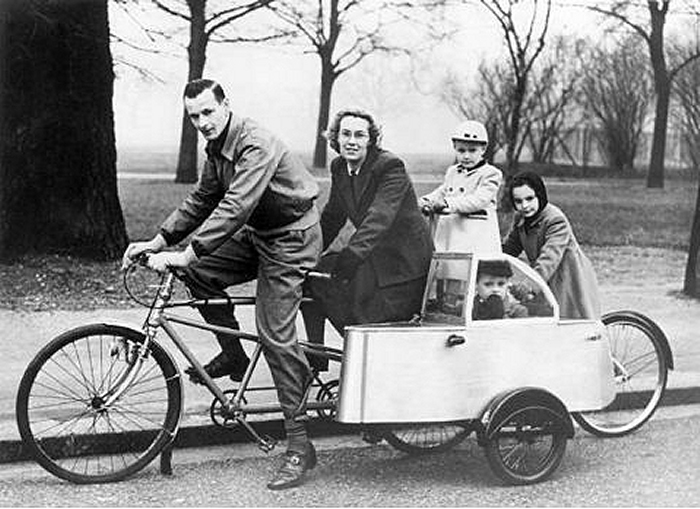 |
| Left: Quartette plus sidecar: 1950
Here's another way to transport five people. Mr Eric Jewell, of Dukes Avenue, Finchley, London, with his wife and children on a 'quinticycle' in 1950, built by adding another wheel to a tandem, and bolting on a sidecar.
|
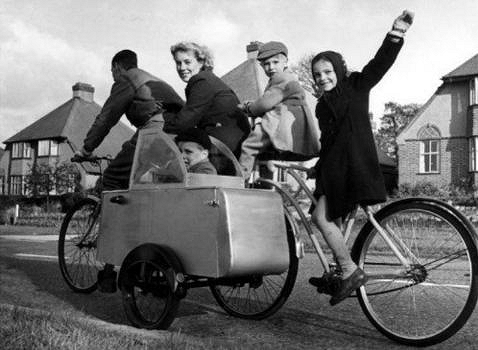 |
| Left: Quartette plus sidecar: 1950
And off we go.
Clearly a different occasion as the clothes are different.
|
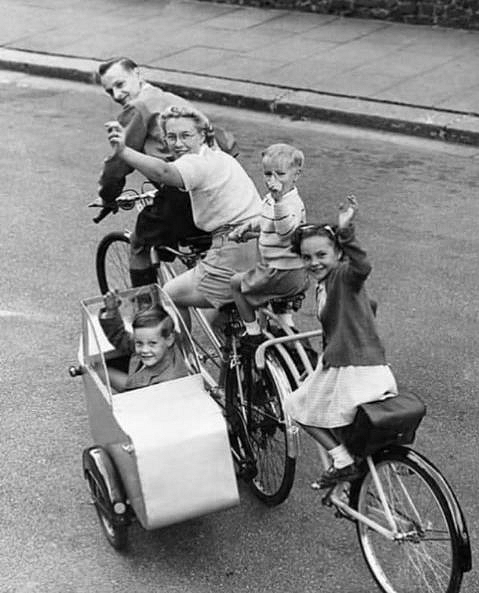 |
| Left: Quartette plus sidecar: 1950
A bicycle with front wheel removed has been grafted onto the rear of the tandem, retaining its pedals and chain so the rearmost rider can contribute to the horsepower.
A different occasion again, judging by the clothes.
|
 |
| Left: Colson Quartette plus trailer: 1940s
Here's another way to carry five people. This is a Colson Cycle Manufacturing Company Quad with two 26-inch wheels. A Jack Taylor ‘Trailercycle’ is attached at the rear; it has pedals and chain so the fifth rider can contribute to the horsepower.
There is more info on Jack Taylor here
The trailer suggests road use rather than pacing, but once again there is no sign of any brakes.
|
 |
| Left: Tandem with Jack Taylor ‘Trailercycle’ attached: 19??
Clearly a promotional picture. That's Jack Taylor on the left and a model on the right.
Note the safety flag at the rear of the trailer.
|
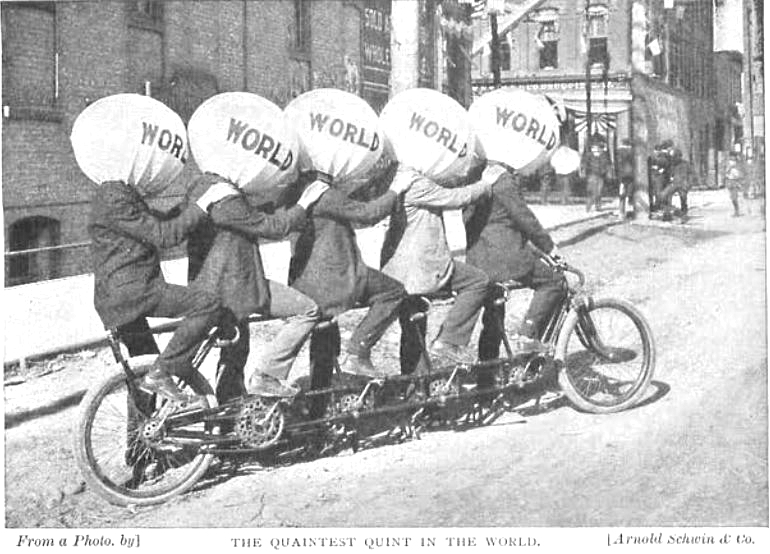 |
| Left: A promotional Schwinn quint: 1898
This quaint quint affair was a promotion for 'World' bicycles. It was built by the Arnold Schwinn company. According to the Strand article, Schwinn said "It is the only successful multicycle ever built" which sounds a highly dubious claim.
The Strand continued: "...all the five riders have their heads concealed in globes, inscribed with the word 'World'. These globes are constructed of light wire and cloth, having a small aperture in front for seeing and breathing."
It must have got quite some attention.
Source: The Strand Magazine Vol XVII-4 1899 (exact date currently unknown)
|

SIX PERSONS
There seems to be no enthusiasm for calling a six-person bike a sext. Can't think why. They are usually called sextets.
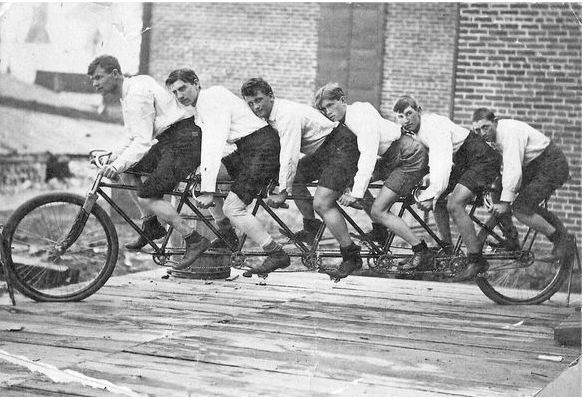 |
| Left: Six-person bike: 1896
The Fowler Sextet was 6-man bicycle built by the Fowler Cycle Company of Chicago in 1896. The Fowler sent the machine all over the US to fairs, parades and bicycle dealers to promote their “truss frame” design, though how you would make a long bicycle without some sort of truss design is not clear. The $3,000 machine is pictured here at Marion, Idaho which it visited 15-18 May 1896.
Nobody looks very happy about it.
The sextet created a sensation when it challenged the Empire State Express, then the fastest train in the world, to a race in 1896. The bicycle’s inventor claimed 100 mph was achievable but it was never clocked at over 38 mph. The $3,000 machine was at Marion on 15th-18th May 1896, and attracted hundreds of watchers. There was talk of taking it for a trial run, but unfortunately (or otherwise) rainy weather made the roads unsafe.
There is more information here.
|
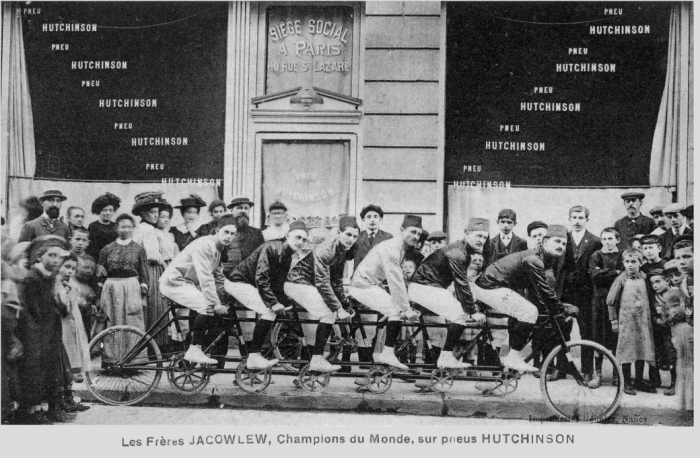 |
| Left: Six-person bike: 19??
This 6-person bike is seen at 75 Rue Saint Lazare, 9° Arrondisemont, Paris. Les freres Jacowlew, described as champions of the world, are shown here on Hutchinson tyres.
It appears there were actually four Jacowlew brothers who were cycling acrobats at the beginning of the 20th century, known in particular for their circus act La Corbeille Mortale. (The Basket of Death, a sort of wire cage like a wall-of-death) Presumably two other riders were pressed into service for this photograph. They pose here on their “extending tandem” to advertise Hutchinson tires; what was extending about it is not clear. Nor is it clear in what way the Jacowlew brothers were 'champions of the world'.
The Hutchinson company still exists.
|
 |
| Left: Six-person bike: 19??
A similar picture taken in Nancy, France. Note chainwheels graduated in size.
In 1890 the Hutchinson company began producing bicycle tyres in Chalette-sur-Loing, France. In 1906 Hutchinson engineers came up with a new single-filament tyre casing technology called Monofil. Claimed to be “stronger than steel,” it became prized by champion cyclists of the era.
|
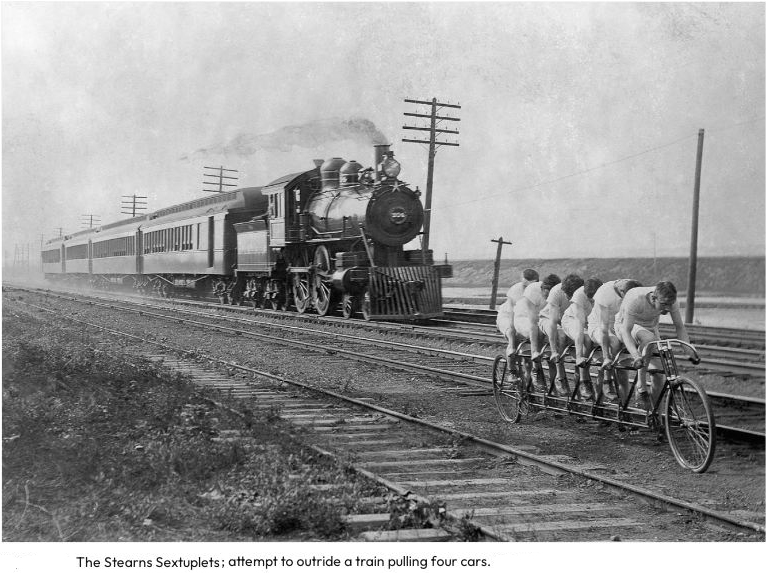 |
| Left: The Stearns sextet: 1896
This is the Stearns sextet racing the Empire State Express near Syracuse in New York State in 1896.
An article in the St. Lawrence and Clayton Independent, July 31, 1896, Page 1, column 3, describes what happened:
"Syracuse, July 29. -- When the westward bound Empire State express was about two miles west of Syracuse, a novel race took place. Between tracks Nos. 3 and 4 six athletic young men on a Stearns sextuplet were kicking the pedals for all they were worth. Arrangements for the race were quietly completed several days ago. At this point is a stretch of cinder path about four feet wide and a mile and a half long. As soon as the Empire hove in sight, after leaving here, the sextuplet got under way. The Empire was soon abreast and the race began. For a quarter of a mile it was an even thing. At the end of a half mile the sex-tuplet was four lengths ahead. The sex-tuplet was then obliged to slow down, owing to a short bridge a quarter of a mile ahead. A number of railroad officers and bicycle men witnessed the race. Arthur Yates, official photographer of the New York Central, took four photographs of the race."
E C Stearns & Co was a well-known bicycle manufacturer of the day. There is more info here.
|
More on the Stearns sextet from The Wheel and Cycling Trade Review:
AMATEURS THE FASTER
Providence, Sept 7
"A scratch race be-tween the Stearns and Syracuse sextet was booked as a feature of the Rhode Island State Fair to-day. The race did not take place, however, owing to the Stearns machine being mounted by a professional crew, while the Syracuse riders were amateurs. The Stearns crew rode an exhibition mile in 2:02. The Syracuse machine was ridden the same distance in 1:58."
Some less than wonderful forward planning there. Note that even with six people pedalling, only 30 mph was achieved.

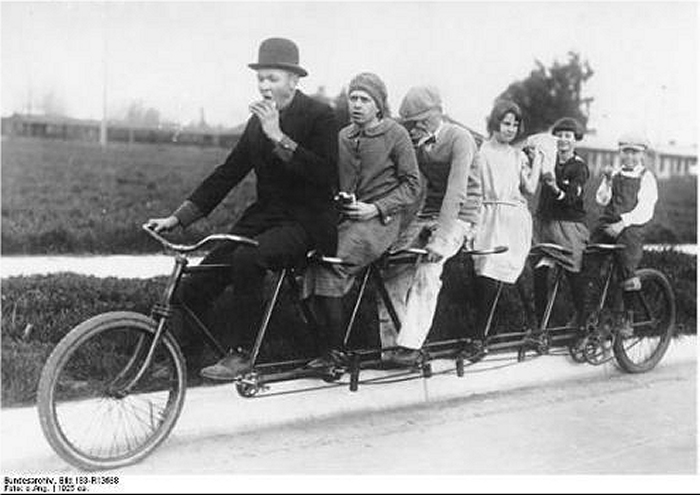 |
| Left: Six-person bike: 19??
This looks like a family eating their sandwich lunch as they bowl along on their sextet; not everyone looks happy about it. Nothing is known about this picture apart from the reference to the Bundesarchive at bottom left.
Note what looks like a double final chain-drive to the rear wheel. That should solve what might be called the power-transmission problem; the front chain only has to transmit the power of one person, the next towards the rear transmits the power of two, and so on. Given this it is surprising that none of the bikes in this gallery show obvious evidence of thicker chains toward the rear. A few have chainwheels increasing in size toward the rear, which would counteract the increases in chain tension; the Hutchinson sextet above and the Oriten 10-man bike are examples. The power-transmission problem was drawn to my attention by Keith Angus.
Source: this picture is from the German Bundesarchive of photographs, so the location is probably Germany. They seem to be on the right-hand side of the road, so it's not England.
|
 |
| Left: Six-person bike: 2014
This custom 6-person bike was built by Steve's Bike Shop in Altadena for CBS, to air in a commercial for their new autumn line up.
|
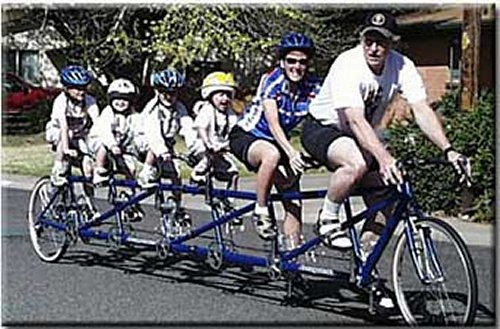 |
| Left: Six-person bike: 2014
This custom 6-person bike was built for family outings.
There appear to be auxiliary chains fitted so that the younger offspring have pedals they can reach, and so can deliver their quota of horsepower. R+E Cycles make a kit for this called the Kidback.
|
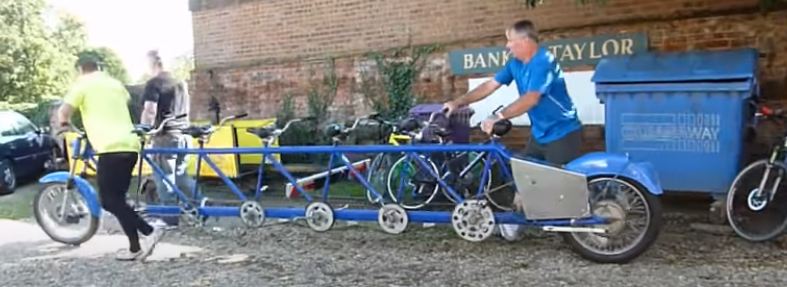 |
| Left: Six-person bike: 2014
This 6-person bike was apparently rescued from Tilbury Docks, and it has been refurbed for future charity rides.
See the YouTube video.
|
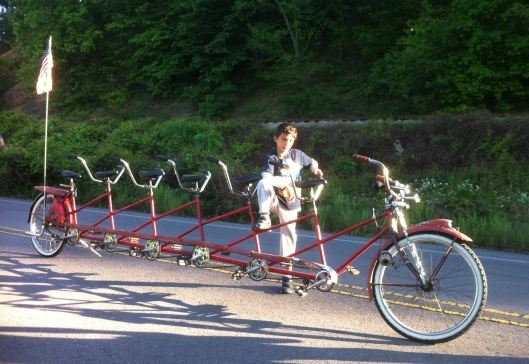 |
| Left: Six-person bike: 2014
All that is known about this 6-person bike is that it was built by its owner, who is in the USA, and he has several of them...
|
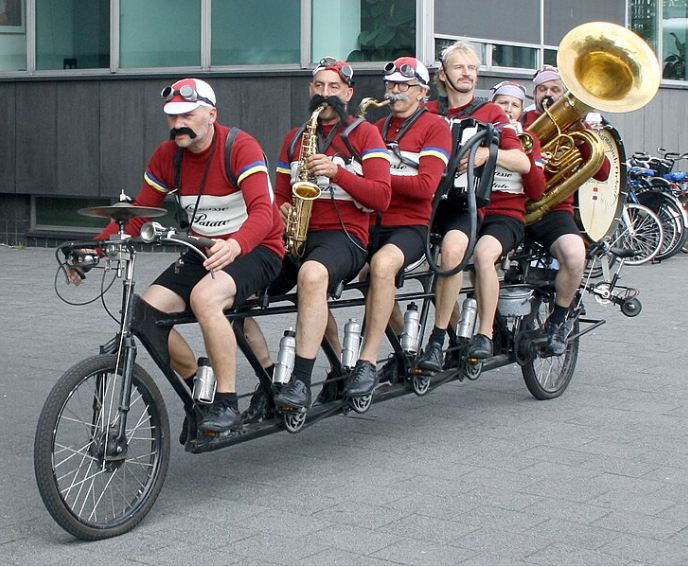 |
| Left: Six-person musical bike: 2013
This is the Brabants Fietsharmonisch Orkest (The Brabant Cycling Harmonic Orchestra) at the World Ports Classic 2013. The Brabants Cycling Harmonic Orchestra is a novelty act in which six musicians cycle and make music on a sextet. It originates from Eindhoven and performs at all kinds of public occasions. The Brabant referred to appears to be the North Brabant province in the Netherlands.
There seems to be a bit more going here than is obvious. The second man (with the alto sax) seems to have a bag under his arm which could be compressed to hoot something. Or maybe it's a tambourine. The fourth man with the accordian seems to have a garden hose connected somewhere, and there is an enigmatic saucepan just in front of the tuba-player.
The Reader Is Warned that not all moustaches are genuine. Note plentiful supply of refreshment bottles.
There is more information here.
You can see them in action (dressed as gnomes) on YouTube. If someone yelled “your stoker’s not pedaling” as the band rolled by it would be true; the video shows that the Tuba player at the rear just has a set of foot-pegs so that he can operate the bass drum by foot.
|
 |
| Left: Six persons on a tandem bike: 1949
A Swedish farm worker takes his family on holiday. You could argue this is two people plus four half-people, so equivalent to four adults, but let's not bother.
The man is Lars Georg Swerin, with his wife Wiran.
|
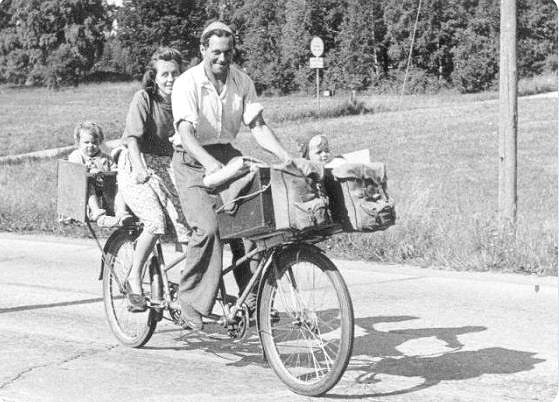 |
| Left: Six persons on a tandem bike: 1949
|

SEVEN PERSONS
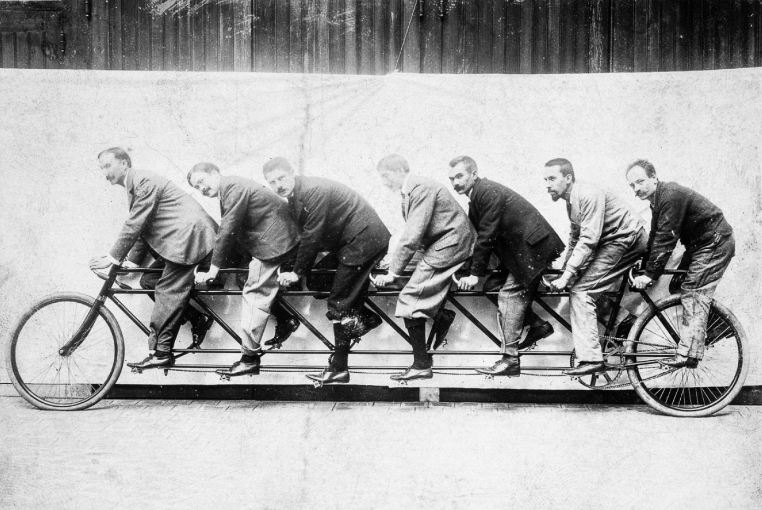 |
| Left: Seven-person bike: 1895
A photograph showing seven Frenchmen on a seven-seater bicycle. (or Septuplet, or septet) This was found in an album of photos collected by Charles Stewart Rolls (1877-1910), of Rolls-Royce fame. Nothing else known at present.
Septuplets seem to have been very rare. It seems likely that quints and sextets exploited the format as far as possible for racing and pacing. and nothing would be gained by adding an extra man and increasing the cost of the machine. Machines for eight or more riders were only built for demonstration or publicity purposes, and not racing.
|
 |
| Left: Seven-person bike: 1964
Left to right:
Bud Brion, Roy Matson, Dick Ellifson, Doug Runkel, Java Bergerson, Arnold Gunderson, Bill Amundson
On Sunday, August 23, 1970, the St. Paul Sunday Pioneer Press, Wisconsin News, published the following article: "30,000 DUE AT STRUM FESTIVAL."
"This is the famous SEVEN MAN BICYCLE......a major attraction at community parades around the Strum area and west central Wisconsin. A Strum product! Built in Strum by Jewel Berge, our Blacksmith, and crew.
"This bicycle also appeared in the Fall 1964 Homecoming parade at the University of Minnesota. I was a student and resident of Frontier Hall Dormitory. I convinced my father to let me bring it to Minneapolis, that I had the guys in the dorm that could ride and manipulate this monster of a bike. Maybe a week before homecoming my friends and I and a Corvair with hitch made the trip to Strum, hooked up the bike and specially built trailer and made the trip back to Minneapolis. The stares along the way through Eleva, Mondovi, Durand, Prescott and then through the St. Paul-Minneapolis Metro area on U.S. Hiway 10........the stares were unreal!"
|
|
"Once we found a parking place for the bike back of the dorm, it was the local attraction around the dorm and Minneapolis campus for days. And then we practiced and the attraction grew. The bell, the air horn fed by that tank on the back of the bike.. A hit as you can imagine."
"This bike and our 7 guys, me being one, were the Frontier Hall entry in the Homecoming Parade. The parade angled down University Avenue on the Minneapolis Campus.....and we snaked this bike along the way, working hard to keep the back wheel on the center line and veering left and right with the front. It worked. We won first prize for all dormitory entries in the parade..........and the stares and hoots never quit!"
"What a great idea my fellow Strumites (or is it Strummers) had for promoting Steam Engine Days....and just about anything! Put a candidate for local or state office on something like this and the voters would never forget the person, just like the memory no doubt caused many a parade goer to never forget this entry in the parade and the NEED to get to Strum on Steam Engine Days each year."
"NOTE: my father, Roy Matson is the second man from the left in this picture. All of these men are well known in the Strum area. In this picture, they obviously are riding in a parade (probably other than Strum) to promote the upcoming Steam Engine Days probably during the mid to late 1960's."
|

EIGHT PERSONS: 2014
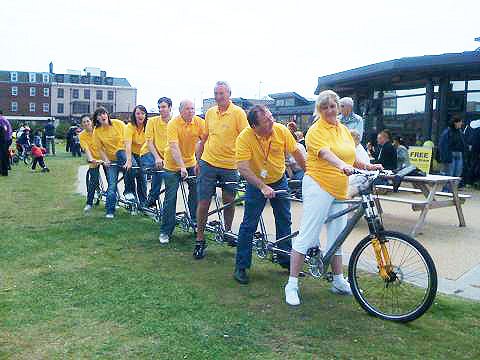 |
| Left: Eight-person bike: 2014
This bike was found on the website of Lancashire Limousines who would like to sell it.
The website has a video of the machine in action, though sadly only with five riders.
There was once a giant 8-person tricycle, built to promote tyres.
|
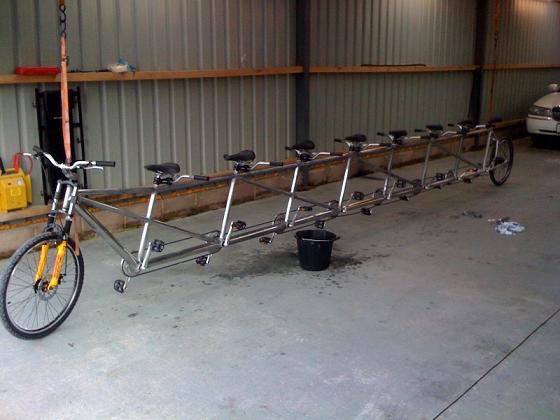 |
| Left: Eight-person bike: 2014
Another picture of the 8-person bike above.
|
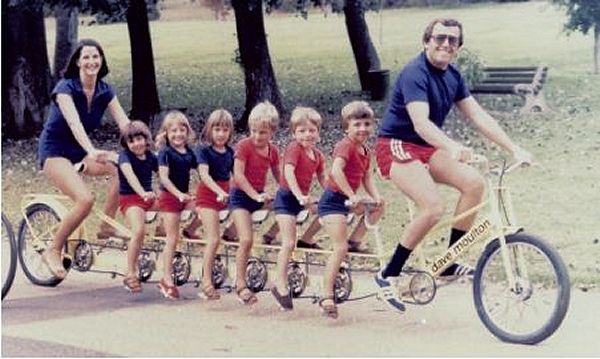 |
| Left: Moulton Eight-person bike: 1978
This eight-person bike was built by Dave Moulton for a photo-shoot of the Rosenkowitz sextuplets, who were born in Capetown, South Africa, in 1974. They were the first sextuplets to survive infancy. Colin Rosenkowitz took sole custody of the sextuplets (plus two other children) after he and Susan divorced in 1989.
The sextuplets were five years old in this picture.
There is more information here.
|
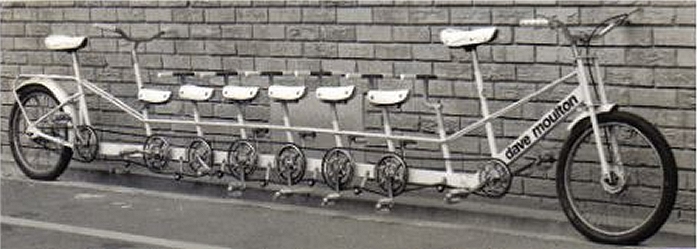 |
| Left: Moulton Eight-person bike: 1978
Looks like a very sound bit of design.
|
 |
| Left: Moulton Eight-person bike: 1978
Probably taken in the mid-nineties. Looks like one of the boys is missing, and the mother certainly is. (Divorce) There seems to be some rust on the chain-wheels.
|
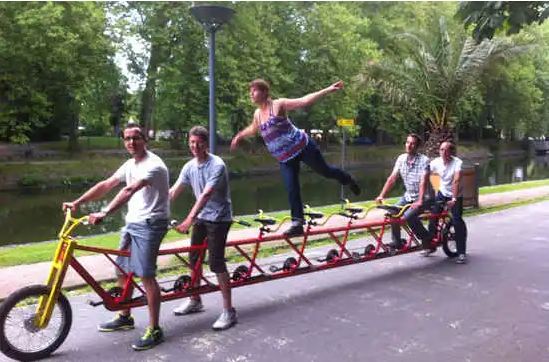 |
| Left: The Grand-Huit (Big Eight) 8-person bike: current
This machine belongs (I think) to an organisation called Lille a Velo, which does not appear to have a web presence. However there is a page called legrandhuit.eu which has several pictures of what they call 'funny bikes', including this one.
|
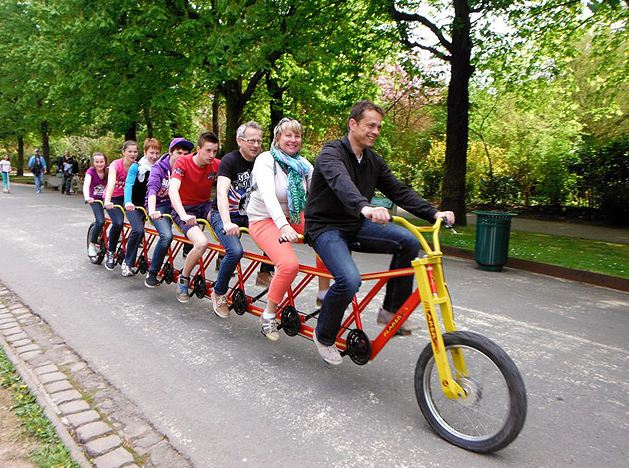 |
| Left: The Grand-Huit (Big Eight) 8-person bike: current
This proves that the Grand-Huit is rideable.
|
 |
| Left: An 8-person bike in the USA: 1981
This machine went on some sort of tour in the USA in 1981. One place visited was Philadelphia.
There is a lengthy video of the bike in action on YouTube.
|

NINE PERSONS
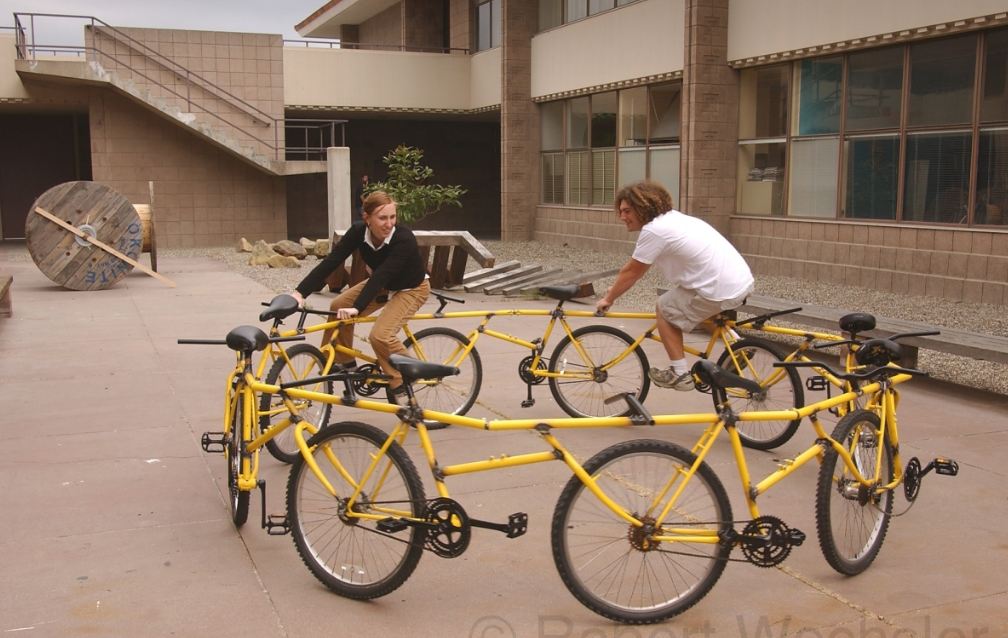 |
| Left: Nine-person carousel bike: 2003
Finding a nine-person bike was never going to be easy, and so this is the best the Museum Staff can do for the time being. The Circular Bike was fabricated from nine salvaged bikes by Robert Wechsler in spring 2003.
Yes, I have noticed that it is not strictly a bicycle as it has nine wheels.
The bike is 3 ft high by 12 feet in diameter; it is modular and can be dismantled, transported and reassembled. It is normally left in public places to attract can attract riders and spectators. Nobody steals it because making a getaway is rather a challenge.
You can see more pictures here.
|
 |
| Left: The BusBike: Nine-person six-wheel 'bike': 2014
The BusBike was fabricated from nine salvaged bikes By Cleveland Motley.
And yes, once again I have noticed that it is not strictly a bicycle as it has six wheels. You will have to live with the fact that when you get up to nine people, the rules are going to get bent a bit.
The machine has Ackermann steering, as used on cars.
You can see more pictures here.
|
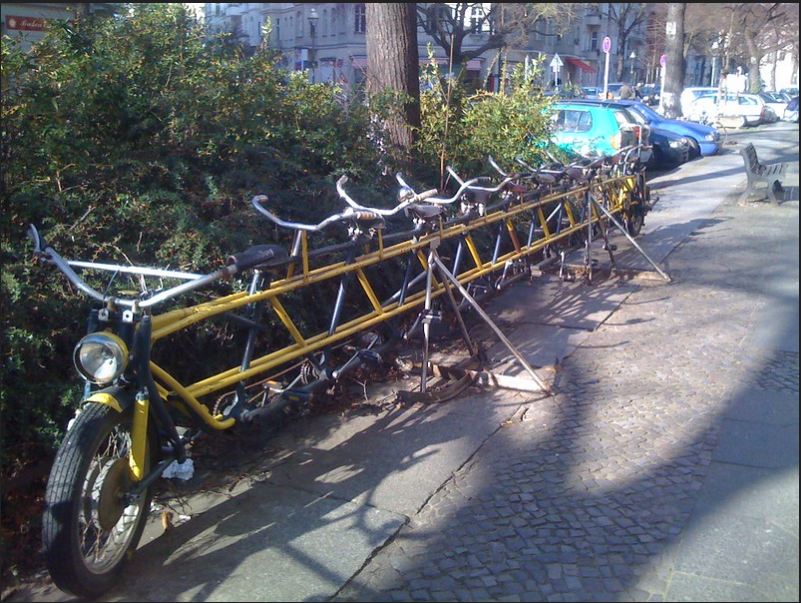 |
| Left: Nine-person bike: 20??
At last- a proper nine-person bike. At least it is as far as I can tell by counting handlebars; it might be a ten-person machine.
For the time being, we will have to live with the uncertainty. Nothing known at present.
|

TEN PERSONS
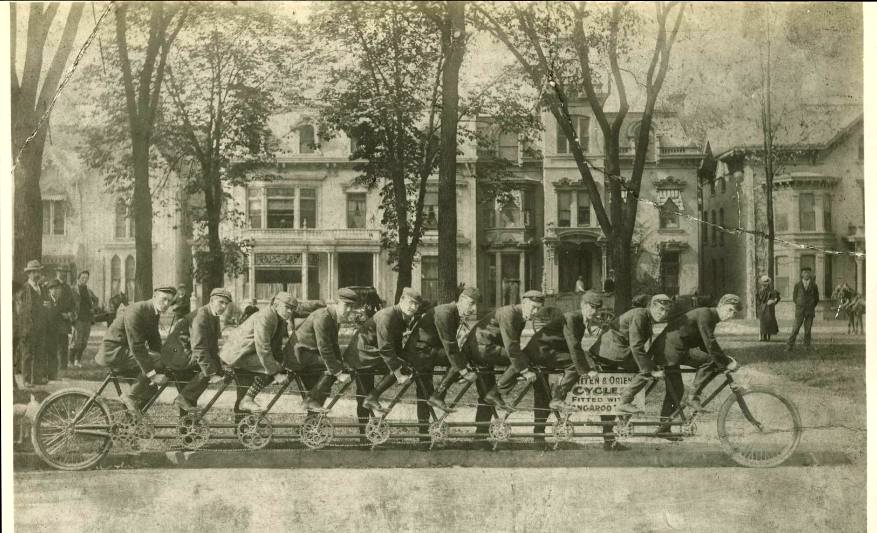 |
| Left: The Oriten ten-person bike: 1896
This one-off ten-person bike was built by Charles Metz of Massachusetts in 1896 to promote his 'Orient' bicycle factory. (Oriten is an anagram of Orient) It is in the Henry Ford Museum. This machine is fairly well known.
The bike is 23 feet long and weighs 305 pounds. It was reported to be very hard to ride. It could reach 45 mph, which required some courage as it had no brakes, nor indeed gears. Note chainwheels increasing in size towards the rear.
Bracing wires can be seen running diagonally downwards from rear to front. The bracing was to improve lateral rather than vertical stiffness.
Location: a street in Detroit, Michigan.
|
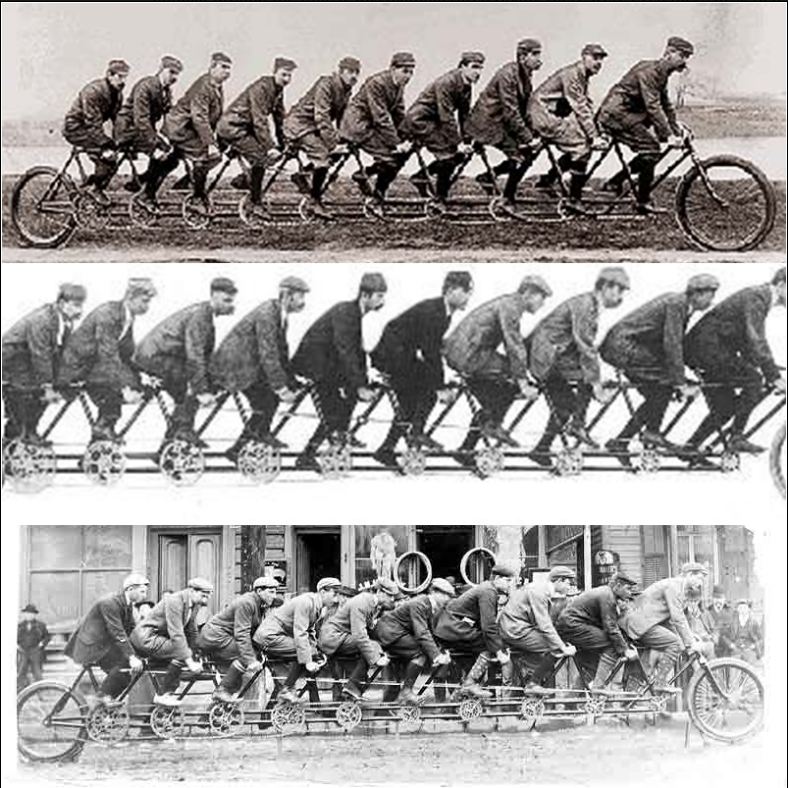 |
| Left: The Oriten ten-person bike: 1896
Here are three more pictures of the Oriten. Looks like the riders were seated a bit too close for comfort.
Intriguingly, the chain wheels get bigger as you move towards the rear, to handle the increasing torque as more pedal effort is added at each seat.
|
 |
| Left: The Oriten ten-person bike: 1896
This is the same picture as the middle one in the triple photograph above.
|
 |
| Left: The Oriten ten-person bike: 1896?
Nothing known about this except the caption. Clearly the Oriten was on tour.
|
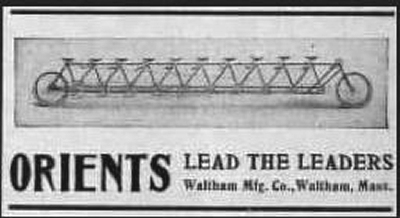 |
| Left: The Oriten ten-person bike: 1896
Demonstrating the Warren Truss construction of the frame.
|
 |
| Left: The Oriten ten-person bike: 1896
Shown here with ten women on board, even though it wasn't exactly a 'ladies model' with a step-through frame.
The photograph appears to have been taken from a bridge. Or is it a painting? Hard to tell, because the resolution is poor. I think the logistical problems of getting ten women in long skirts onto the bike would have been formidable.
Location: Waltham. (Note handy sign bottom left) Note also conveniently lettered rock on the extreme right.
|
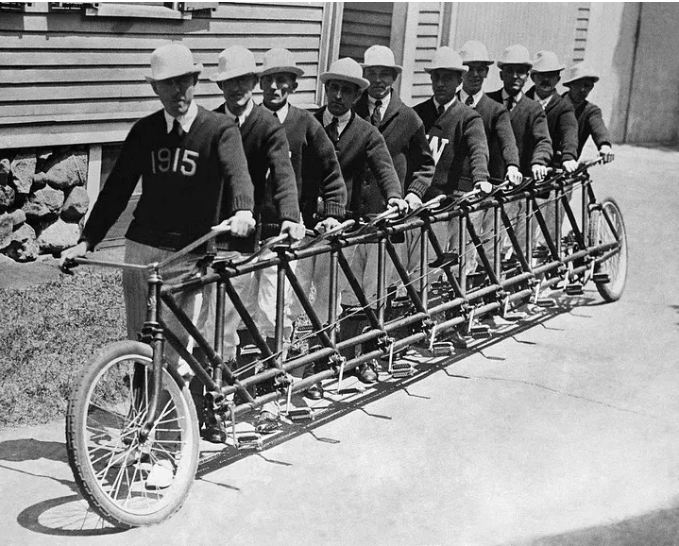 |
| Left: The Oriten ten-person bike: 1915
This is pretty clearly a later outing of the Oriten bike, identified by it full-length diagonal bracing. Judging by the jerseys this is a group of college students in 1915.
|
 |
| Left: The Oriten ten-person bike: date unknown
In this image, the crew are dressed for racing, pacing, or record attempts. The names of the ten riders were: H. Batchelor, W. Day, J. Warburton, C. Chapple, A. Chapple, H. Allen, L. Edwards, H. Hutchings, F. A Pettis and W. Berberg.
|
 |
| Left: The dimensions of the Oriten ten-person bike: date unknown
Note the chainwheels increasing in size towards the rear of the machine, to cope with the increasing amount of torque to be handled.
|
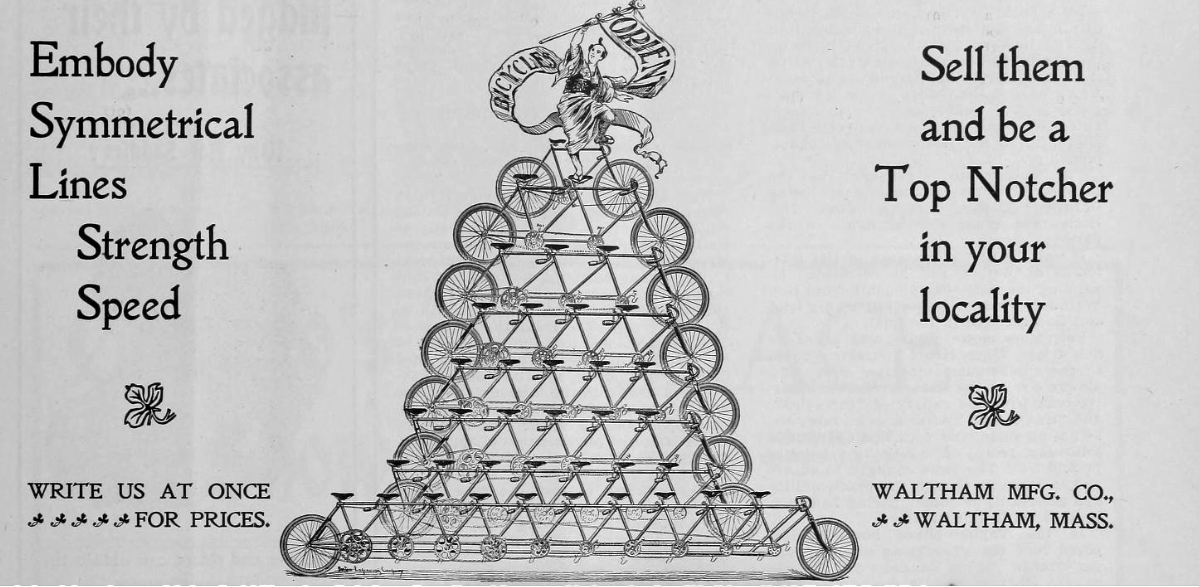 |
| Left: Oriten advertisment: date unknown
This ad implies that Orient made conventional bicycles, tandems, and all sizes up to a seven-man bike. There is no sign of a 8 or 9-man machine. The ten-man Oriten was a one-off.
Note the Chinaman at the summit of Bicycle Mountain.
|
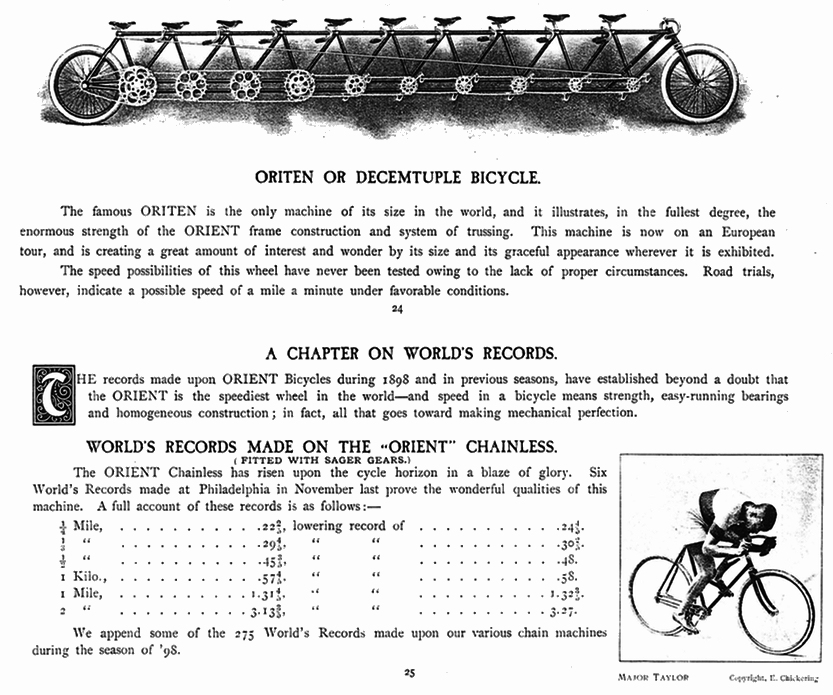 |
| Left: Oriten advertisement: date unknown
Note the ad admits that the speed capability of the Oriten had never been tested, "...owing to the lack of proper circumstances." which would presumably include a very long straight road and ten men willing to risk their lives.
The word 'decemtuple' does not seem to have caught on. A mathematician would probably refer to it as a 10-tuple.
The chainless Orient shown below had a shaft drive with two sets of bevel gears, described as Sager gears; J H Sager was best known for patenting various kinds of suspension that could be added to bike frames.
In the USA alone, there were at one time more than 20 manufacturers of “chainless” bicycles.
|
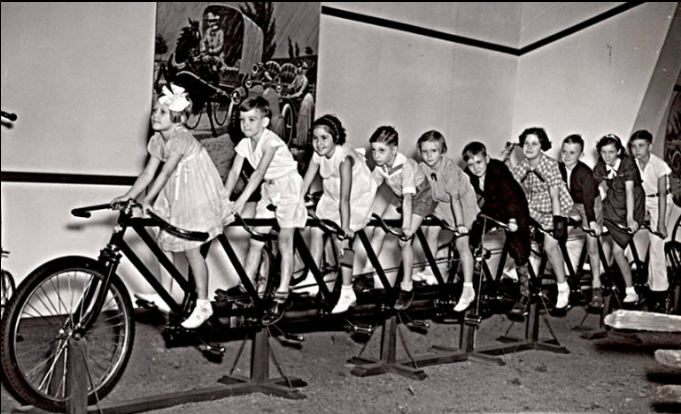 |
| Left: Ten children on the Oriten: date unknown
This is obviously the Oriten again, identified by the diagonal bracing wires. The crew is made up of alternate girls and boys. The Oriten is mountd on stands, and the photograph was probably taken in the Henry Ford Museum.
The date is unknown, but judging by the children's clothes is in the 1940's or 1950's.
|

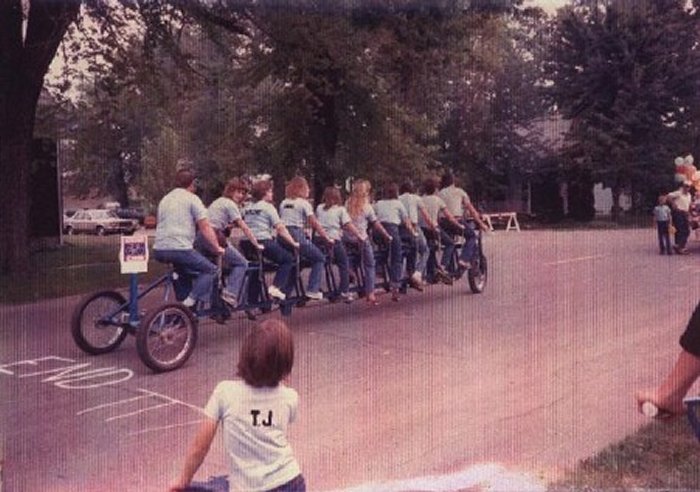 |
| Left: The Unicycle Factory ten-person bike: 2010
If you thought the Oriten was a singular aberration, think again. The Unicycle Factory built this 10-person bike. There are hydraulic brakes on the front wheel.
I am aware there are two wheels at the back, but as with nine-person bikes you have to be a bit flexible. Stability at parade speed was the problem, solved by the two rear wheels.
You can see more at sillycycle.com, and there is a YouTube video of it in action. (uploaded June 2010)
|
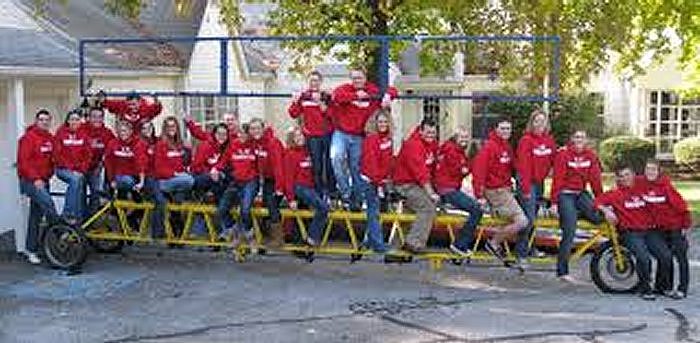 |
| Left: The Unicycle Factory ten-person bike: 2010
Another view. Note the large top tube, which appears to be about 4 or 5 inches in diameter. The top tube is in compression rather than tension, and so needs to be strong enough to resist buckling.
The frame has been repainted at some point.
Image quality poor, I'm afraid.
|
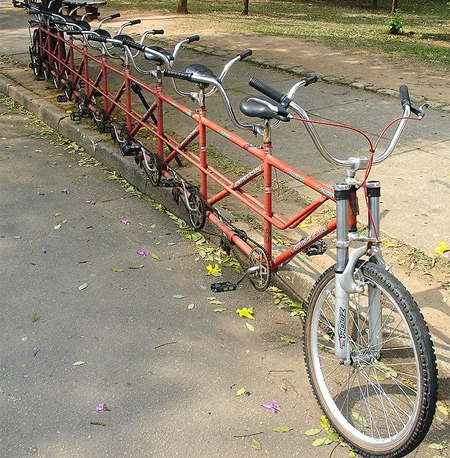 |
| Left: Unidentified ten-person bike: date?
Found on the Interwebs. Can anybody identify this machine?
Note the extra bracing. It looks intended to improve lateral rather than vertical stiffness, as in the Oriten above.
Photograph 7 June 2008
|
 |
| Left: Unidentified ten-person bike: date?
Note the unusual chain setup; there is one long chain that is kept in contact with the chainwheels by small idlers.
I think the clothing of the passers-by suggests the USA as the location, but that is speculative.
|
 |
| Left: Unidentified ten-person bike: date?
At least this machine has some brakes, though given the long cable run to the rear wheel, the back brake was probably not very effective.
|
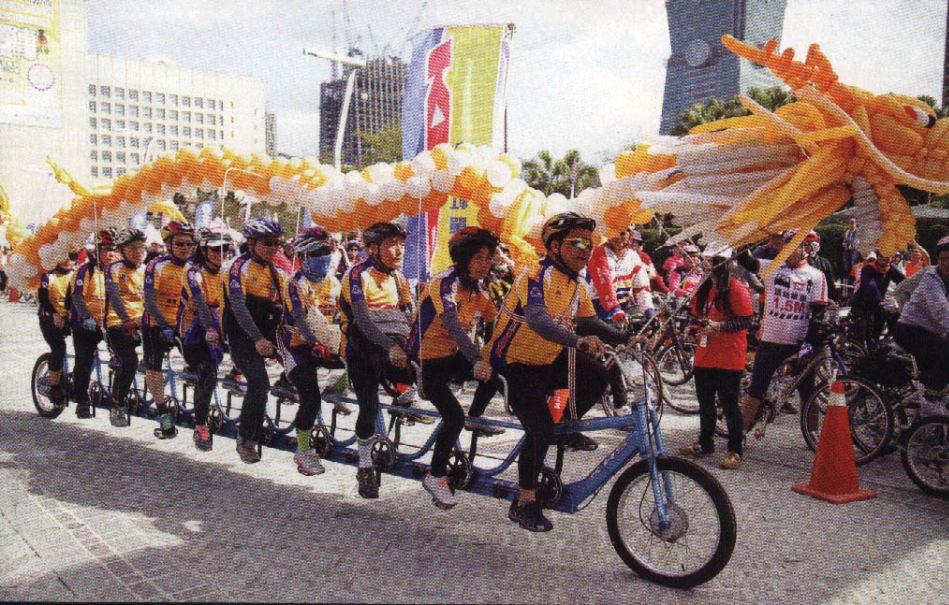 |
| Left: Asian ten-person Dragon-bike: 2016
This ten-person Dragon-bike appeared in the Velo-city cycle parade in Taipei, capital of Taiwan, in February 2016. The bike carries a dragon made up of balloons; a highly impressive effort. The heavy bottom tube marks it out from the other ten-cycles in this section. No technical details are currently known.
At least this machine has a front brake, and judging by the cabling, a back brake as well.
|
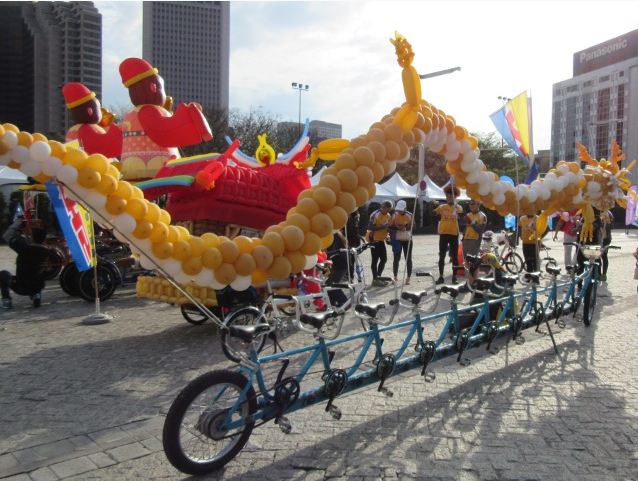 |
| Left: Asian ten-person Dragon-bike: 2016
Another view of the Dragon-bike.
Yes, definitely a rear brake-drum there.
|
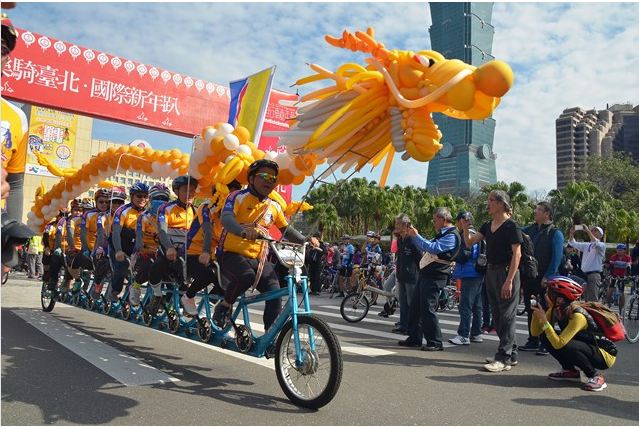 |
| Left: Asian ten-person Dragon-bike: 2016
Another view of the Dragon-bike.
There must have been an army of volunteers to blow up all those balloons.
|
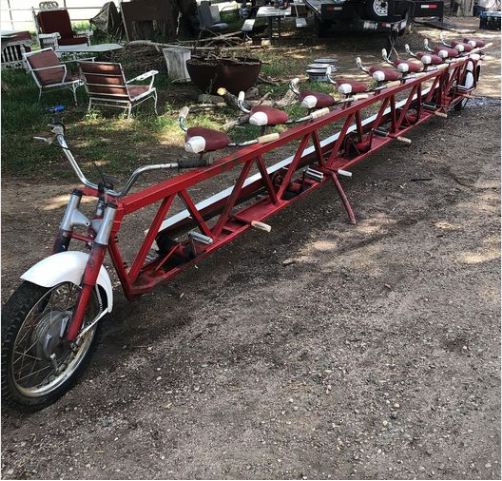 |
| Left: Green CHEK ten-person bike: date unknown
You wait for ages for a ten-man bike and then two come along at once (see above for the other)
It was built by Green CHEK Solutions of Colorado USA, for reasons unknown. There is a Facebook page; scroll down to see the bike.
|
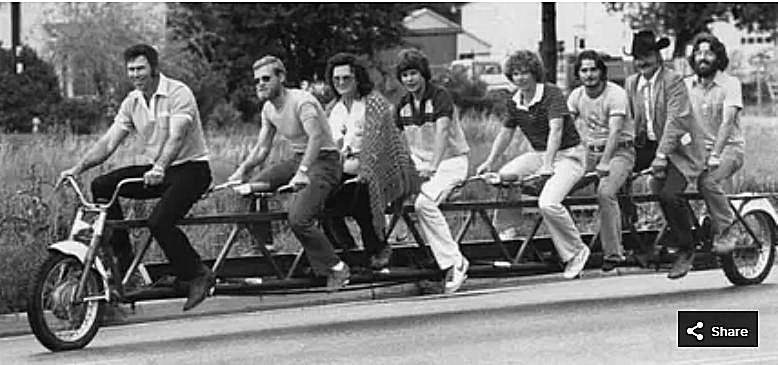 |
| Left: Ten-person bike by Bill Swets: 1981
A ten person bicycle in Fort Collins, Colorado, in 1981. It was built by Bill Swets, owner of Green CHEK Solutions and the Swetsville Zoo metal sculpture park. It is the same machine as in the photograph just above.
There are only eight people aboard here.
|
 |
| Left: Ten-person bike: date unknown
Mayor Hudnut steers a 10-person bicycle during an event on Monument Circle to promote the National Cycling Championships at the Major Taylor Velodrome in Indianapolis.
This appears to be a different ten-person bike from any of the others in this section.
|

THIRTEEEN PERSONS
 |
| Left: Thirteen-person bike: 1968
This is a still from the 1968 film The Bliss Of Mrs Blossom.
In the background a thirteen-person bike rides by.
It is not a well-known film, though the cast included Shirley MacLaine, Richard Attenborough, Patricia Routledge, and Bob Monkhouse.
Frank Thornton, Barry Humphries, and John Cleese also make brief appearances in the film.
Here is the relevant bit of video. The thirteen-person bike is unknown to Google.
|

FOURTEEN PERSONS
 |
| Left: Fourteen-person bike: 1967
This fourteeen-person machine was built to take part in the Coventry Carnival in 1967.
A contemporary news report from 19th June 1967:
"The longest thing on two wheels, the " Quatrodecimalopede, earned astonished stares when its 14 lusty young riders pedalled to take part in Coventry Carnival. It is 31 1/2 feet- longer than a Corporation bus- and the man on the front had an almost Herculean task, especially going round corners. It looked as if there ought to be what seafaring men would call an after-steering position. But the young men who built this 14-seater juggernaut were out for a world record and this is what they are claiming.
The fantastic machine is built from steel scaffolding tube, in two parts, slotted and bolted together. Its motley crew sat on a varied assortment of scrap saddles, and, as if it were necessary, gave warning of their approach by klaxon and hunting horn. During their journey the old bathtub they were towing to catch contributions overturned. It looked as if the tub would travel better in ballast so they stopped for some stone to weigh it down. But still it gave trouble and their journey to the War Memorial Park was fraught with difficulty, even after they jettisoned it in Hollyfast Road. A major problem arose when they shed a crank and chain wheel. Never mind, the 14 - most of them rugger men and not easily daunted - have won themselves a contract to appear in a comedy film."
|
More info here.
|

TWENTY PERSONS
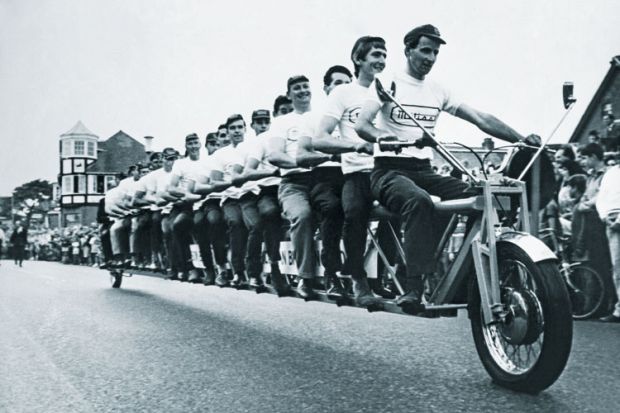 |
| Left: A twenty-person bike: Jan 2001?
This is clearly a different machine from the one below, and it appears that it is not only sleeker and lighter, but does not require a giant roller at the back to keep it upright. The location is New Milton, Hampshire, England; it was presented to the New Milton carnival. Note that some sources describe it as a motorcycle, and I must admit I can't see any pedals in this view. But neither can I see an engine.
|
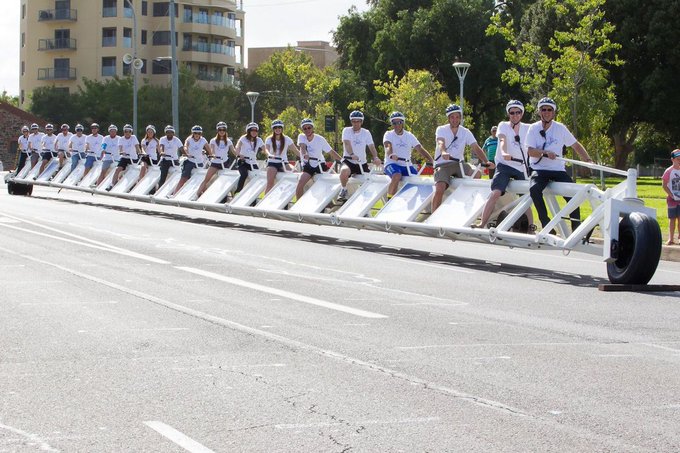 |
| Left: A twenty-person bike: 2015
This monster machine is currently the record holder in the Guiness Book of Records. The frame is a big triangular girder, to obtain sufficient rigidity. The bike had to be ridden a distance of 100 metres without stabilisers to prove that it is "rideable" and so qualifies for a Guiness record. To make this possible the rear 'wheel' is more of a giant roller. The machine is 136 feet long.
It was built in 2015 by the University of South Australia, with support from the gas and oil company Santos.
There is an intriguing video of this monster on YouTube
|

TWENTY-ONE PERSONS
 |
| Left: The twenty-one person Blue Peter bike: 5th October 1972
The 'Vigintipede' of 1972 was a bicycle made for 21 riders. It was made for a charity ride by Littlehampton Rotary Club.
Actually only the rear 12 riders were provided with pedals. The steering is done by one rider at the front, so 8 people are just along for the ride.
Note the hefty front wheel. Is that Ronnie Barker (1929 - 2005) at the front? Yes. Ronnie Barker joins Blue Peter presenters John Noakes and Lesley Judd on the Vigintipede at the Blue Peter studios, on 5th October 1972.
|
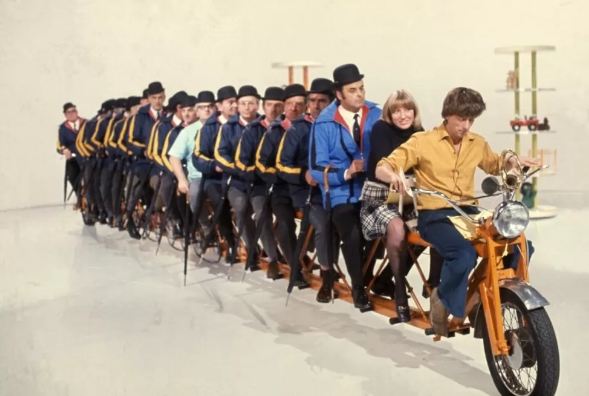 |
| Left: The twenty-one person bike: 1972
A rearrangement of personnel. The pair at the front are Blue Peter presenters John Noakes and Lesley Judd.
It appears that here the Vigintipede is being kept upright by the judicious deployment of furled umbrellas, to go with the bowler hats.
|
 |
| Left: The twenty-one person bike: 4th Oct 1971
This image has been touted on various sites as showing a 22-person bike, but in fact it shows 21 riders, with only the rear 12 pedalling. This is obviously another picture of the Vigintipede.
The bike was 35 feet long, and weighed two tons when fully manned.
|

THIRTY-FIVE PERSONS
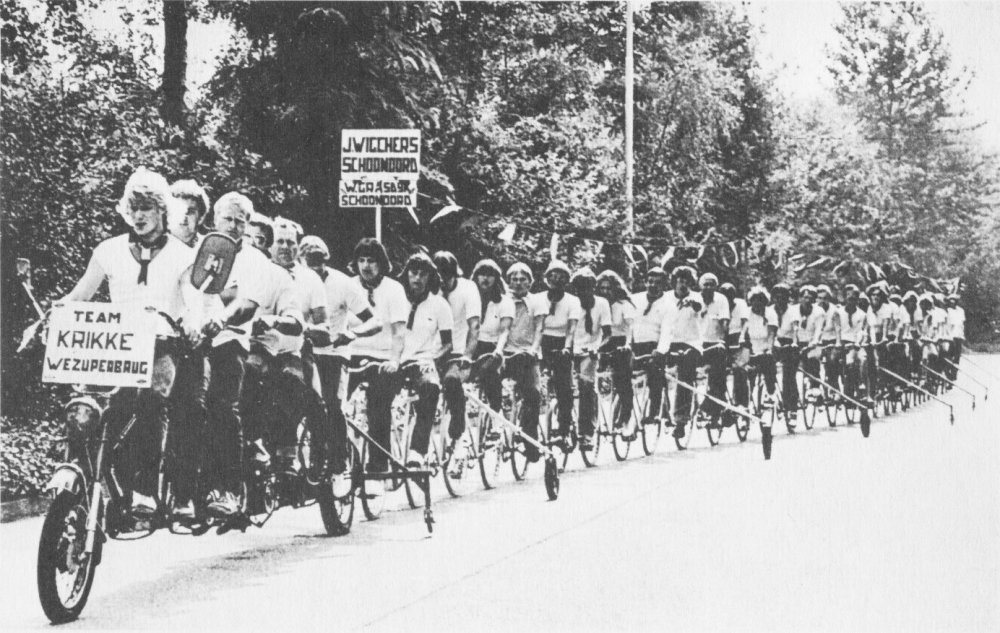 |
| Left: A thirty-five person bike in Holland: 1981
I am aware this is not strictly a bicycle. In fact. it's not at all clear how many wheels it has; the front section, carrying five people, is a heavy-framed tricycle. The rest of the machine consist of ordinary bicycles joined together in some way that is not visible; there looks to be one bicycle wheel per person.
There are (I think) eight pairs of stabilising wheels. There are certainly at least 29 people in the picture, though the count rather fails at the far end due to lack of definition. The placard in the middle is attached to the machine; it presumably carries sponsorship information; investigations are in progress. Schoonoord is the nearest town to the village of Wezuperbrug.
|
There is a Youtube video of this machine appearing in a Dutch television program De Eerste De Beste (Simply The Best) in 1981. There is a brief view of the machine in the opening sequence from 0:44 to 01:07. The audio is in Dutch.
Don't miss the dance routine at 13:28.
The notice at the front tells us this is Team Krikke, a cycling club from Wezuperbrug, which is a small village in the Netherlands with a population of about 180. Perhaps it was bigger in 1981, for it (and presumably the surrounding area) was able to come up with 35 young lads. A. Krikke of Wezuperbrug built the bike; this was the second attempt as the bike-building team was disqualified the previous year by the TV program because of some unclear regulations (according to Krikke) and they were beaten by a 31 meters long bicycle. There is a newspaper report here. In the last paragraph of the article Krikke says he likes constructing weird things and was brooding on something else.
After the TV-program A Krikke received several invitations to demonstrate the bike but the need for a truck and a bus to transport the bike and its riders made this too expensive. The bike was shown to a Japanese TV-crew.
There was a professional racing team from 1986 to 1992 called PDM managed by Manfred Krikke, which I thought might be relevant, but apparently not. There was an unfortunate doping scandal in the 1991 Tour de France.
Source: Further Transports of Delight by Spike Milligan. This is a collection of photographs with misleading captions that were intended to be humorous. They are not.
No source information was given by Mr Milligan, but the front of the book says it was Popperfoto. I have never met Mr Milligan, but I have met people who had, he said darkly.
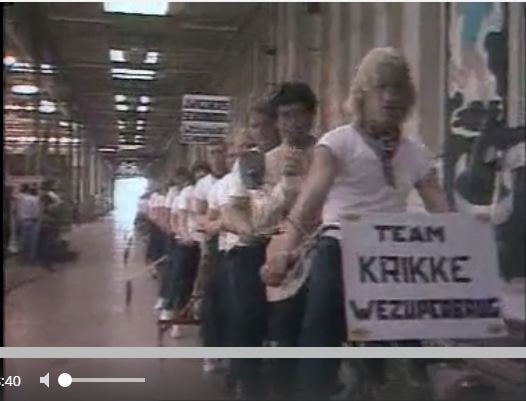 |
| Above: A thirty-five person bike in Holland: 1981
This picture comes from the Dutch TV program mentioned above. The same chap is steering as in the b/w picture above.
It doesn't add much to our knowledge of the machine.
|
 |
| Above: A thirty-five person bike in Holland: 1981
From the Dutch TV program mentioned above. It doesn't really add much more than proving that the machine really existed, while the video proves it could move and stop in an orderly manner.
|
 |
| Above: A thirty-five person bike in Holland: 1981
This pic from the video proves the machine could move along a road. So long as no corners were involved.
|
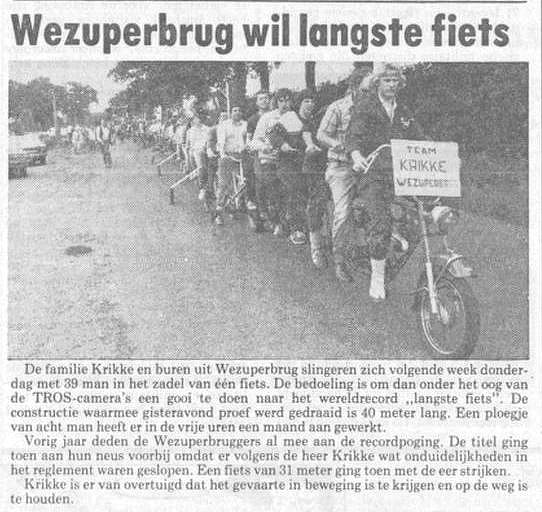 |
| Above: A thirty-five person bike in Holland: 1981
Newspaper report on the bike. Note that it says it was a 39-person bike, not 35-person.
Translation:
"The Krikke family and neighbors from Wezuperbrug will swing themselves next Thursday with 39 men in the saddle of one bicycle. The intention is to take a shot under the eye of the TROS cameras; The construction with which the test was run last night is 40 meters long. A team of eight men worked on it for a month in the free hours. Last year, the Wezuperbruggers participated in the record attempt. At the time, the title was ignored because, according to Mr Krikke, some ambiguities had crept into the regulations, when a 31-meter bicycle took the credit. Krikke is convinced that the colossus can be moved and kept on the road."
Source: Nieuwsblad van het Noorden for 30-07-1981
|

FORTY PERSONS
 |
| Left: Possible forty-person bike: date unknown
This image comes from the Velovision website. The link on that site only goes to a 'not found' page in Japanese.
At first it was unclear if this was a real machine or a Photoshop job. However, details like the bell on the handle bars and the extensive frame underneath that keeps the machine standing up incline me to think it is is real.
This website gives a length of 26 metres and claims that there are forty seats on the machine, but no other information is given.
The Museum Staff are investigating, but I can tell you now that Googling 'forty-person bicycle', and variations thereon, yield nothing relevant.
|
An image search eventually produced the (unconfirmed) information that it was built by the Mijl van Mares Werkploeg in Maarheeze, Netherlands, and measures 35.79 m (117 ft 5 in) in length. It was first ridden on 5th August 2011. According to one report it was actually a 35-person machine.























































